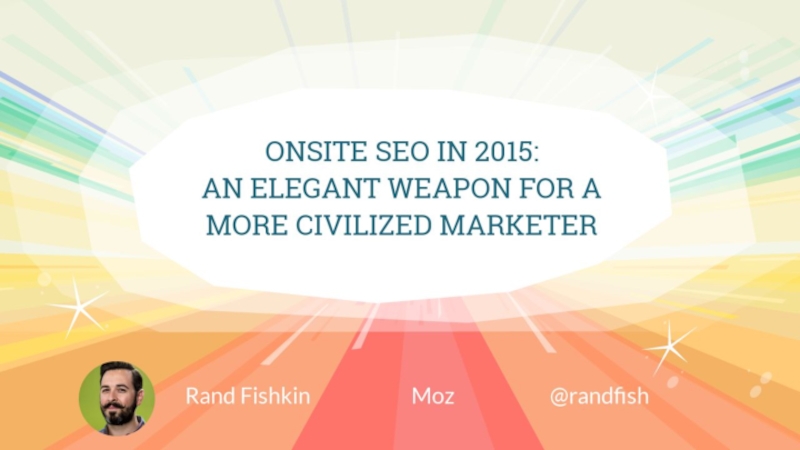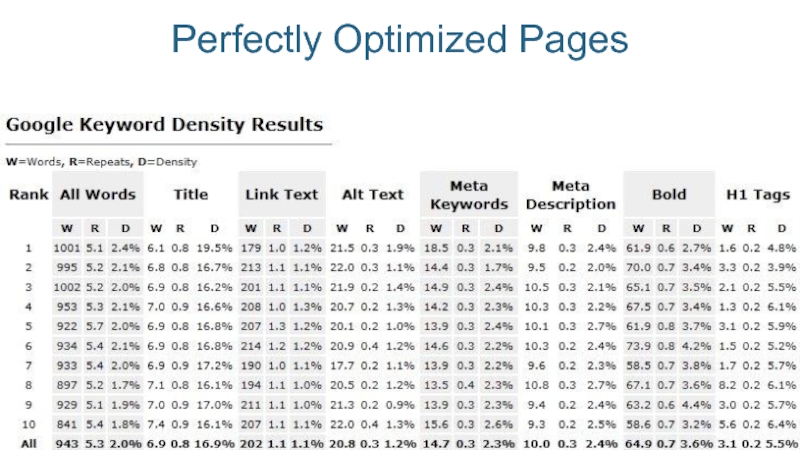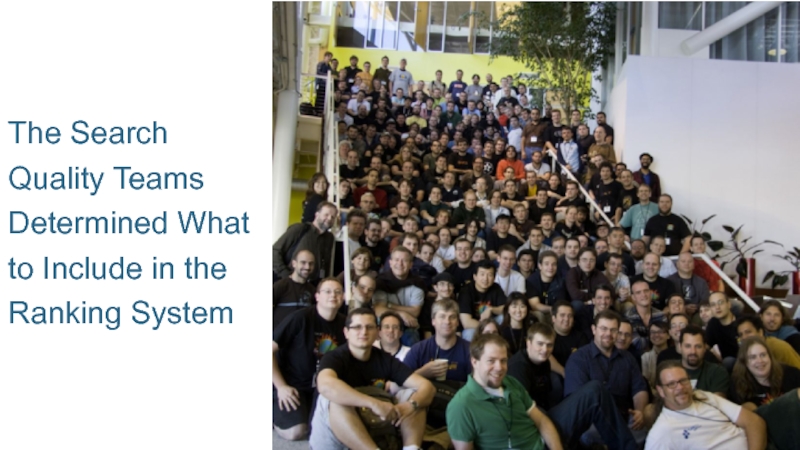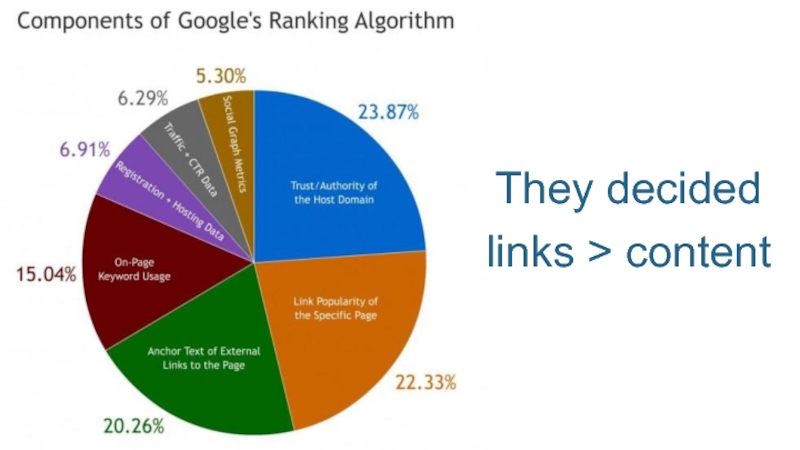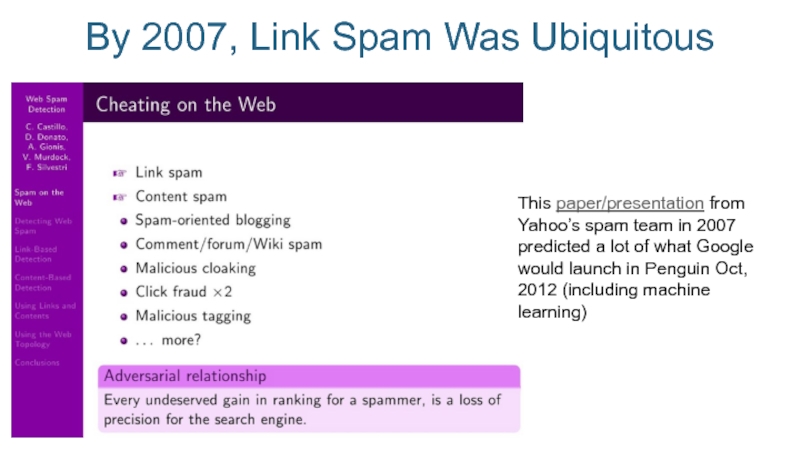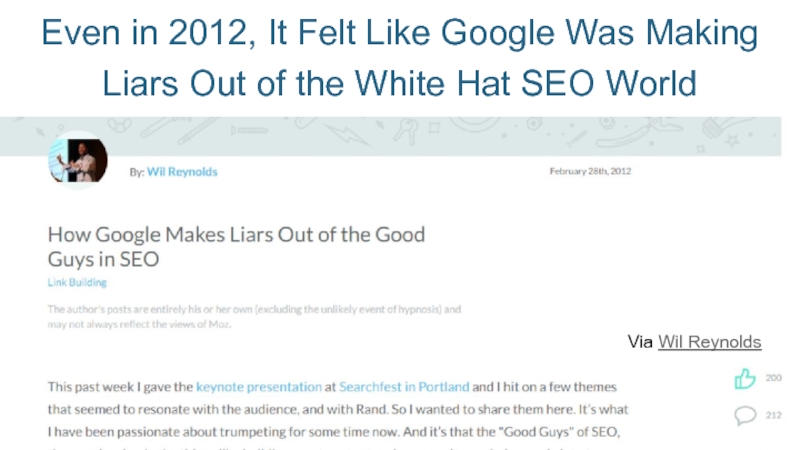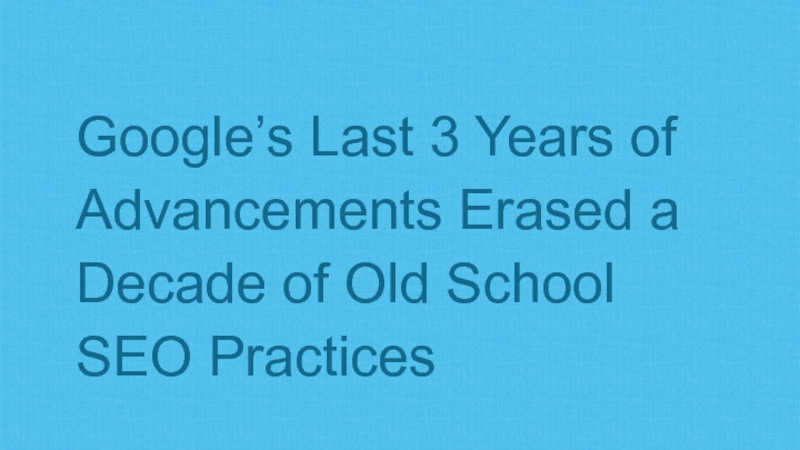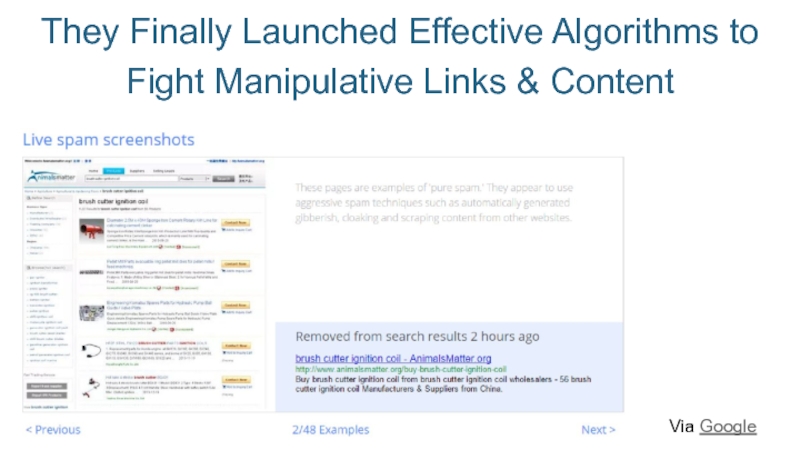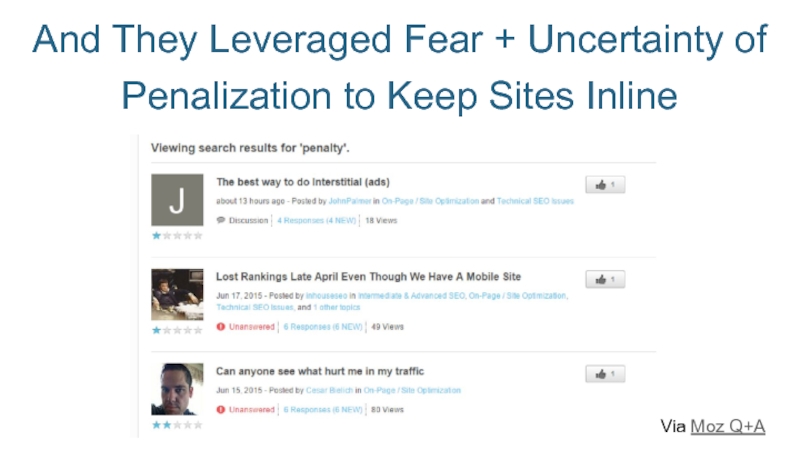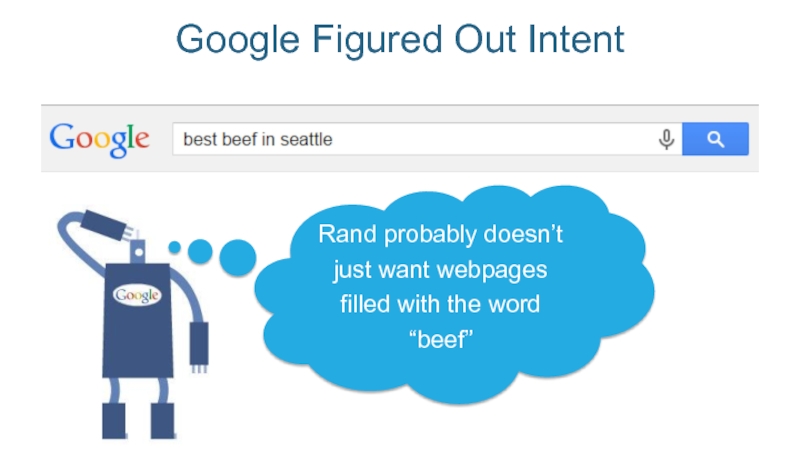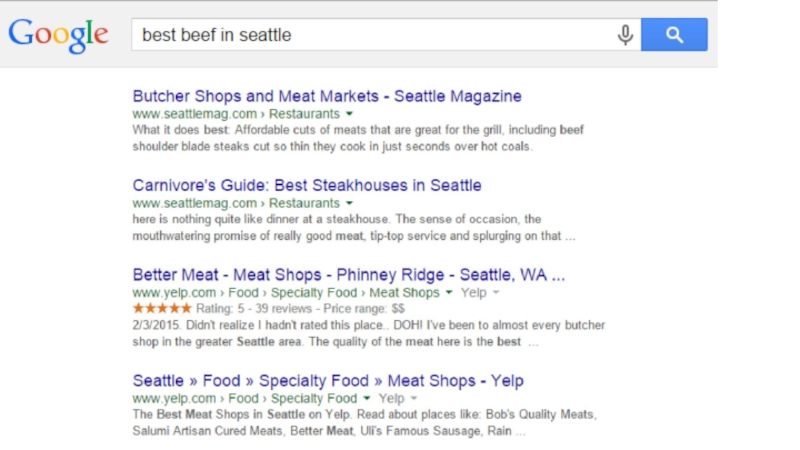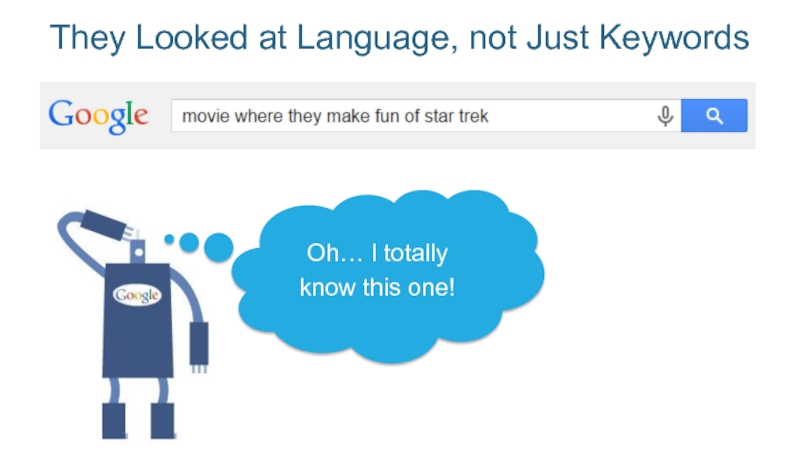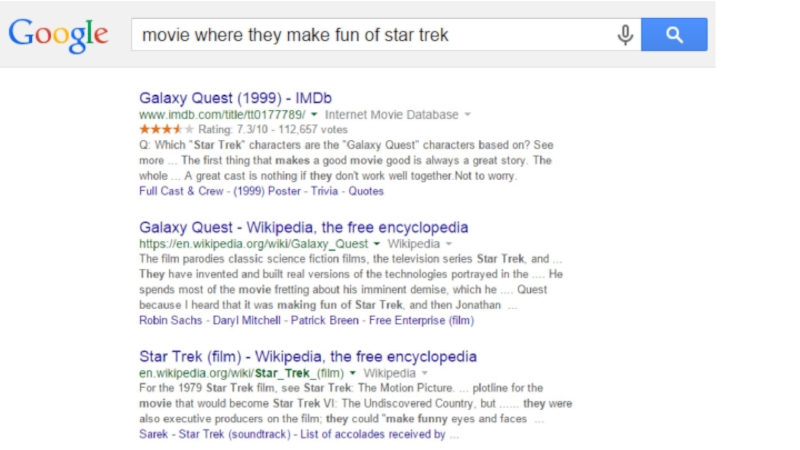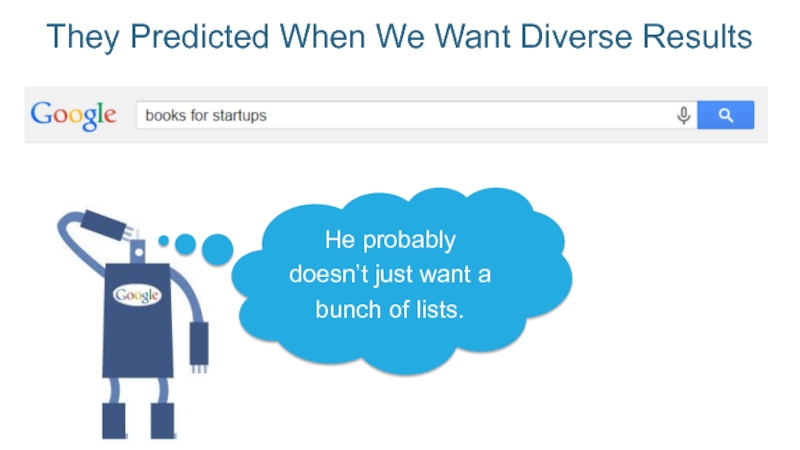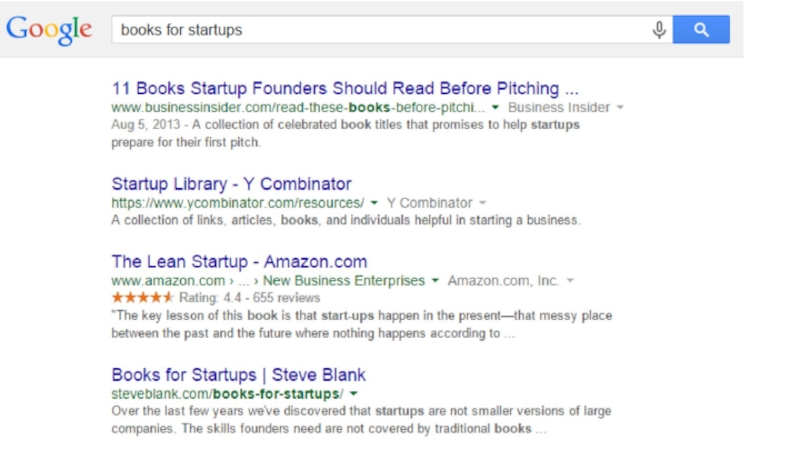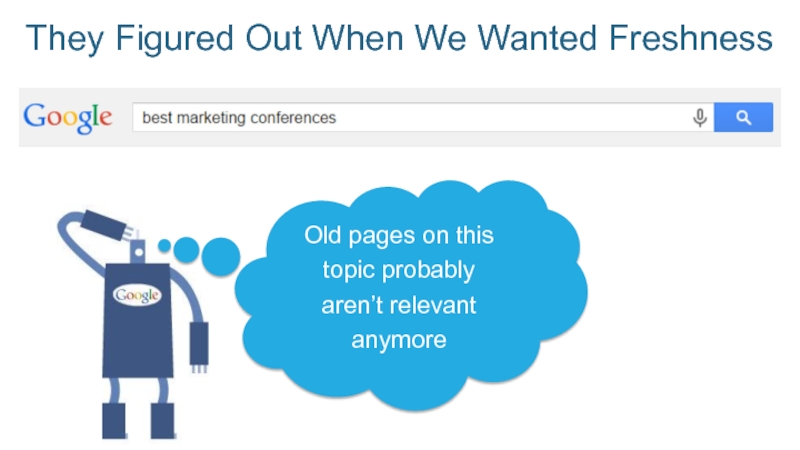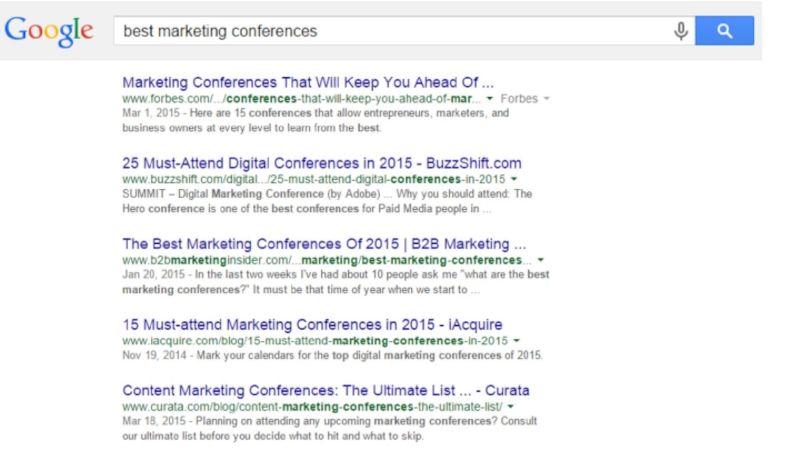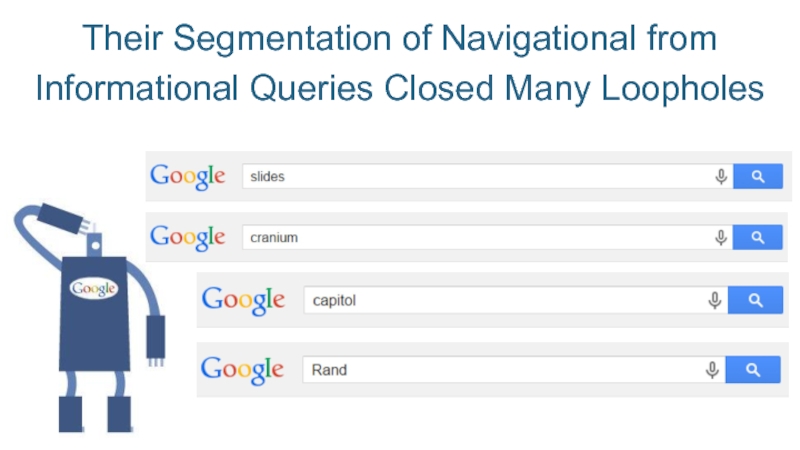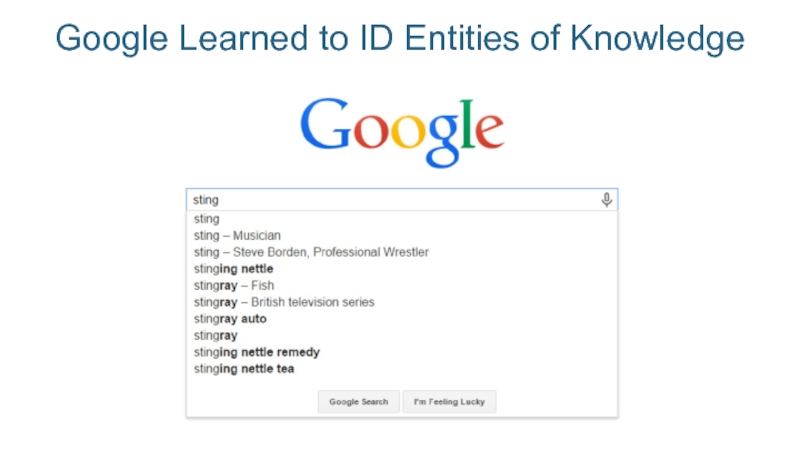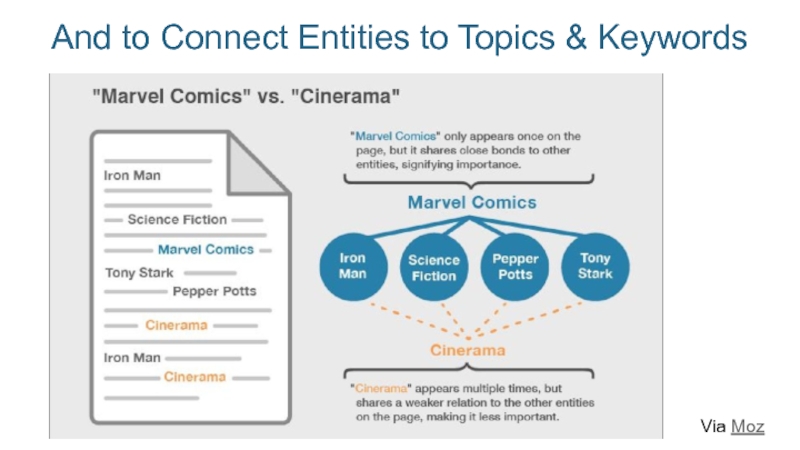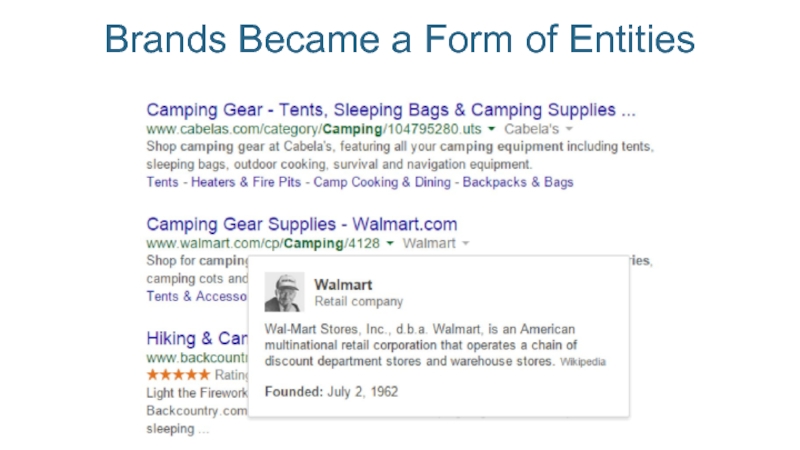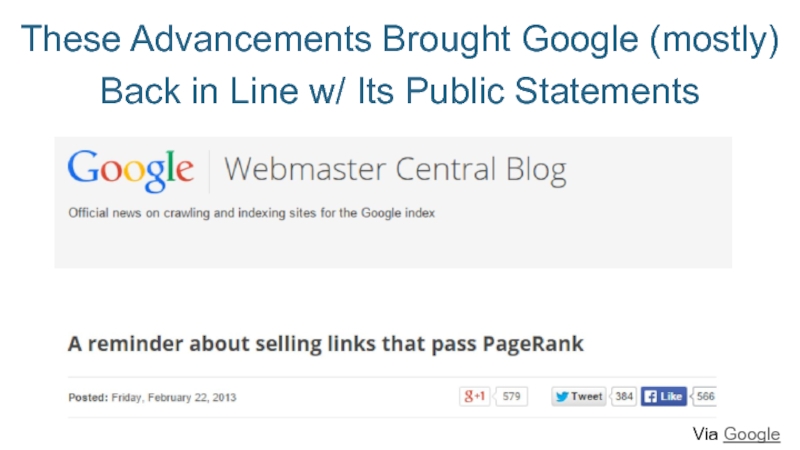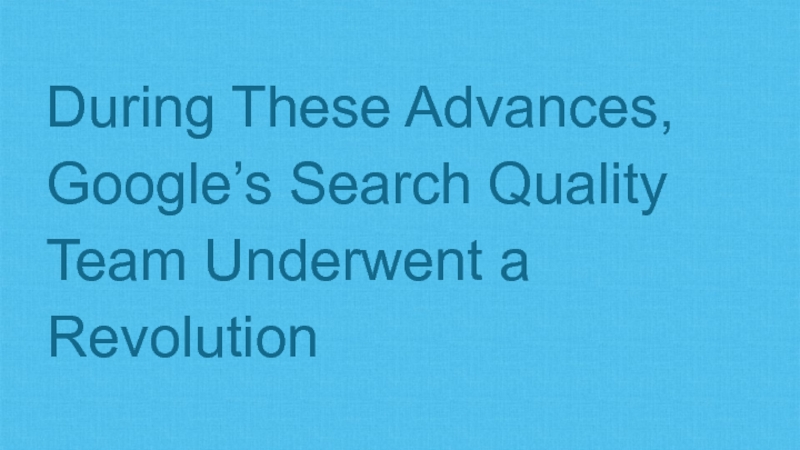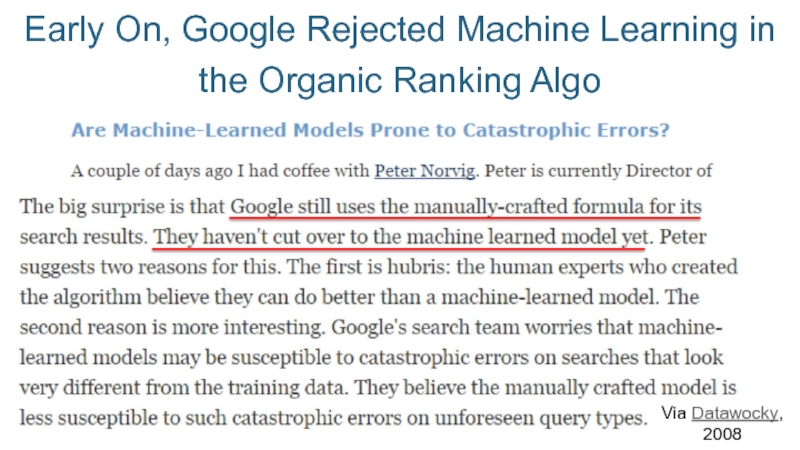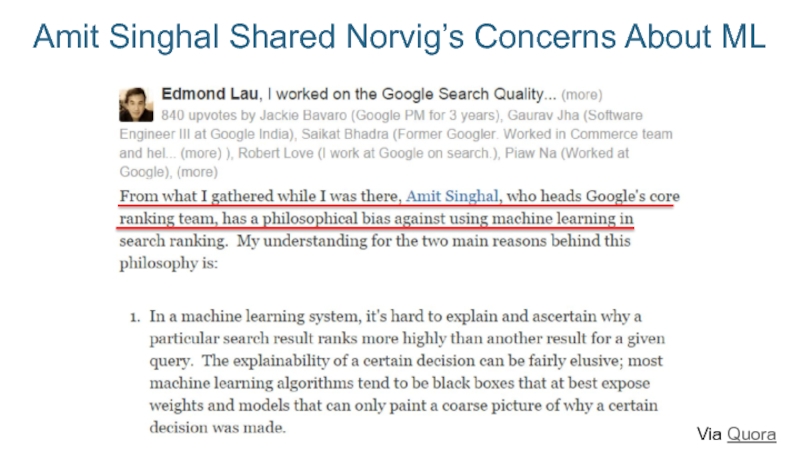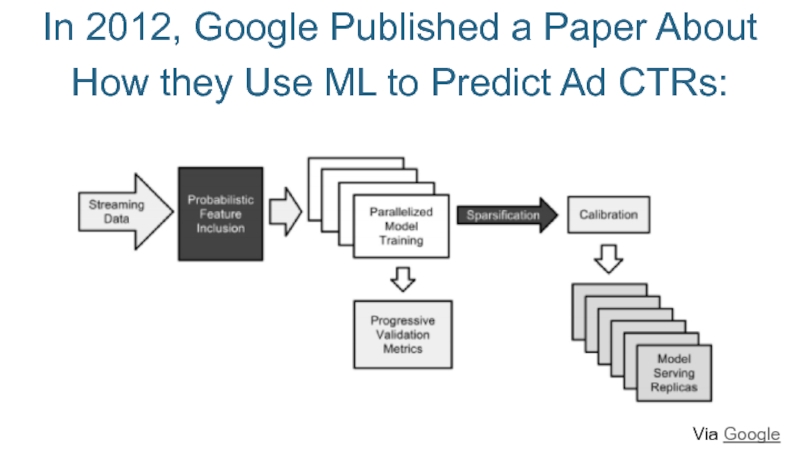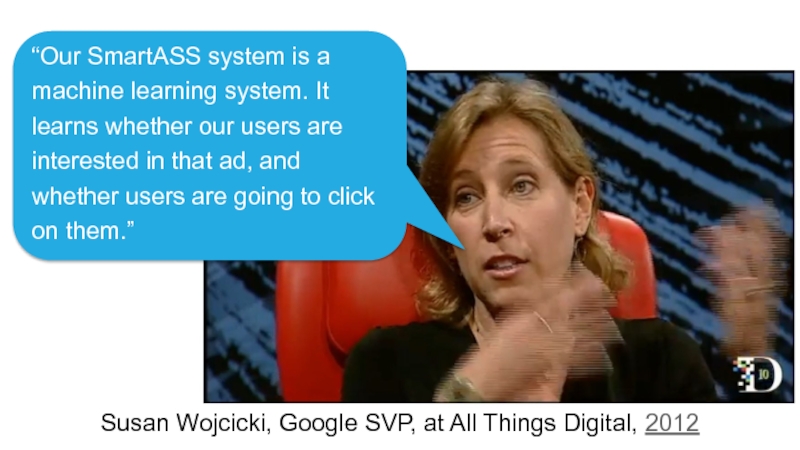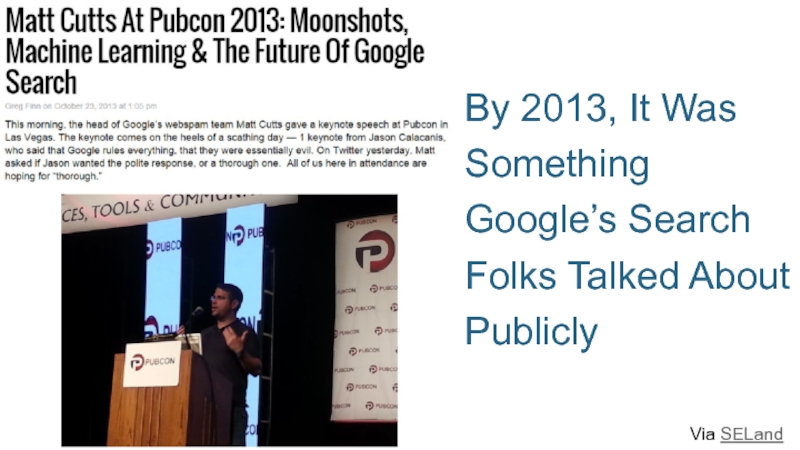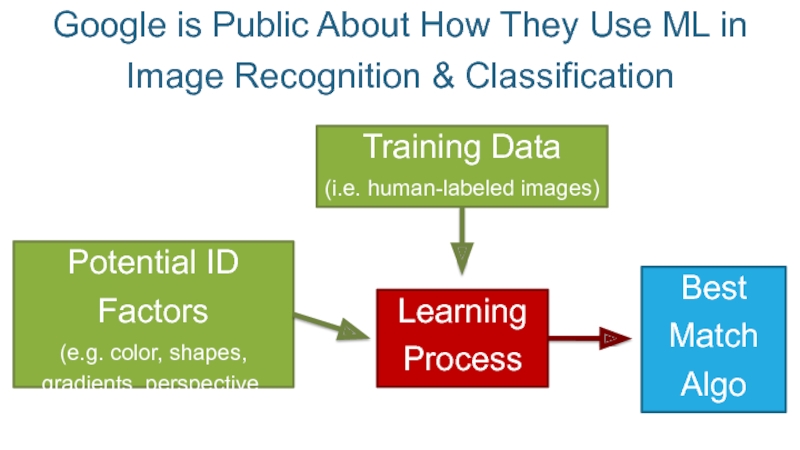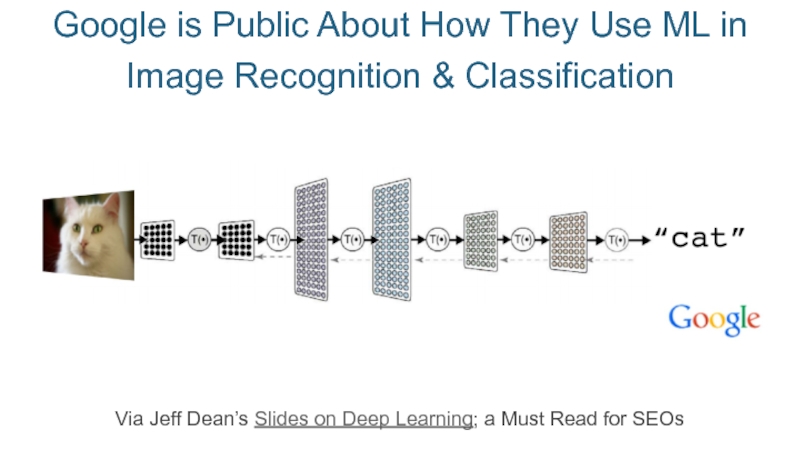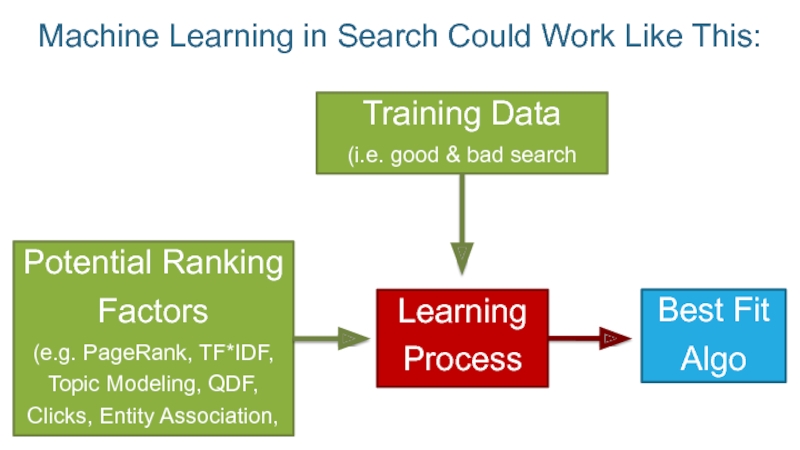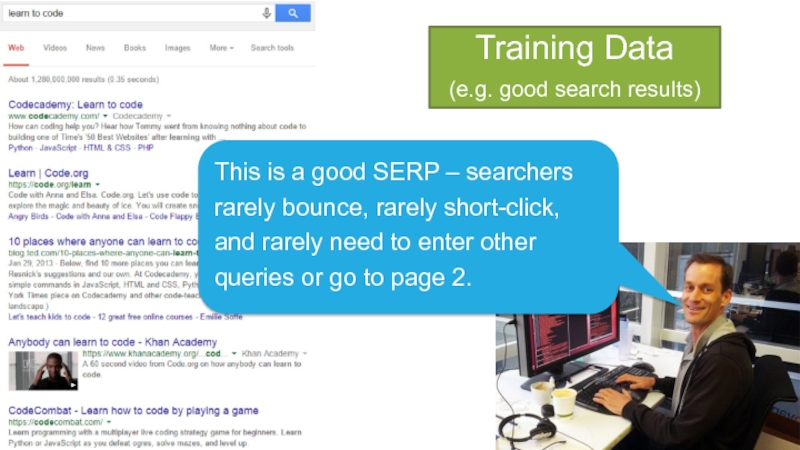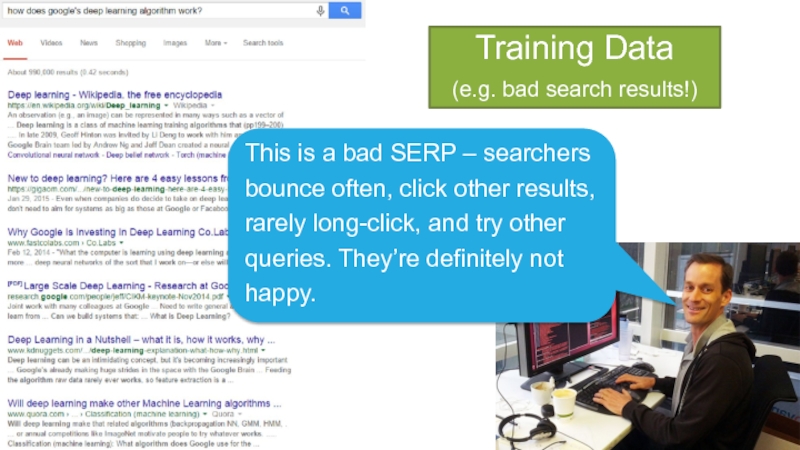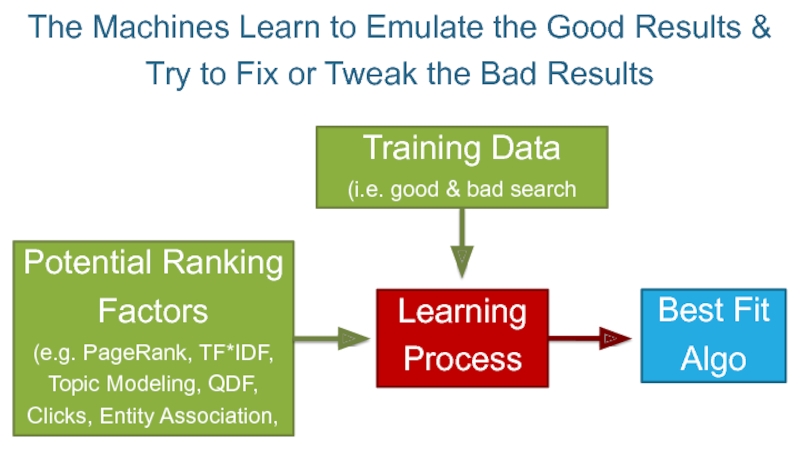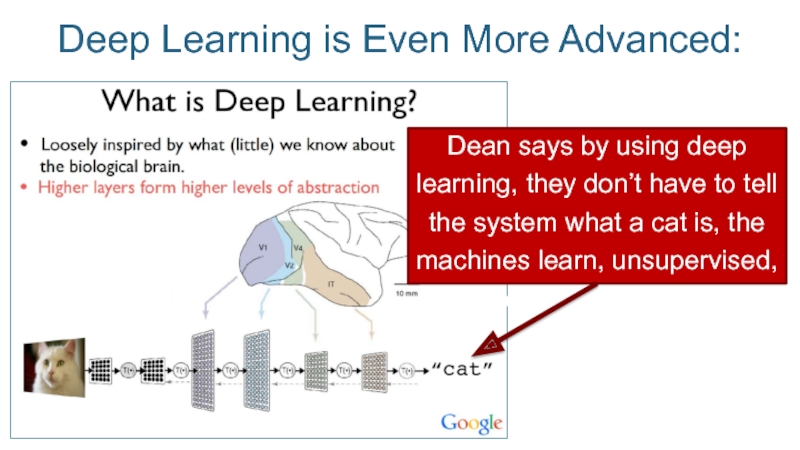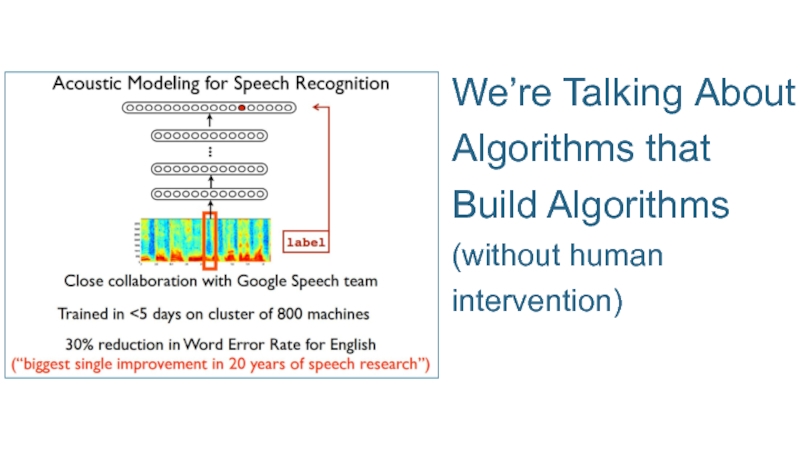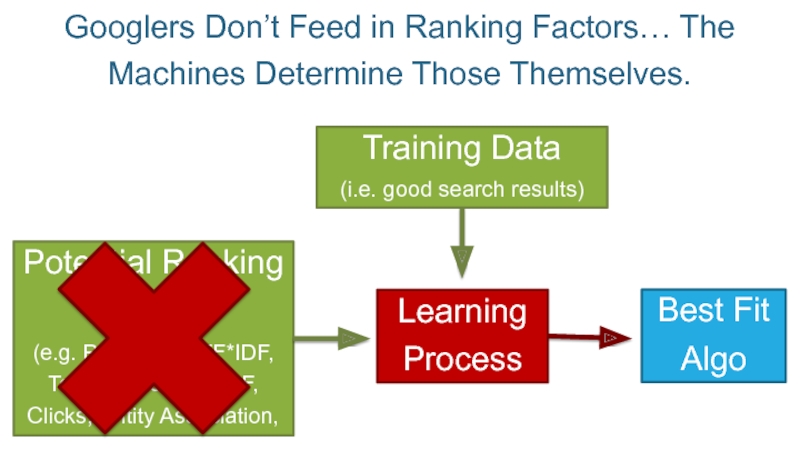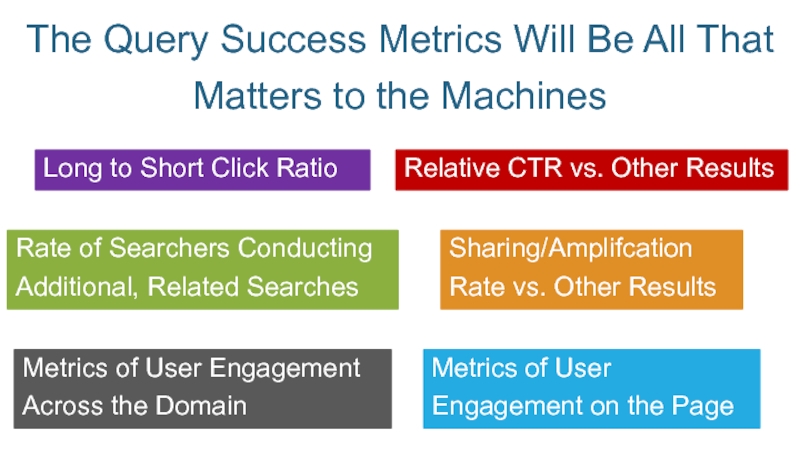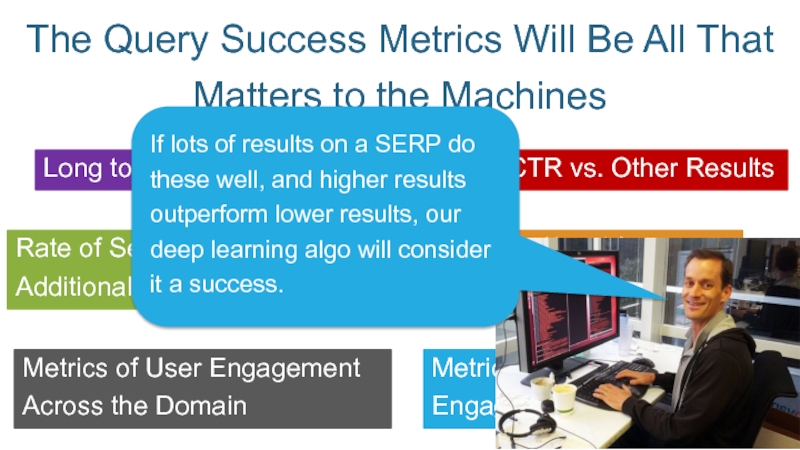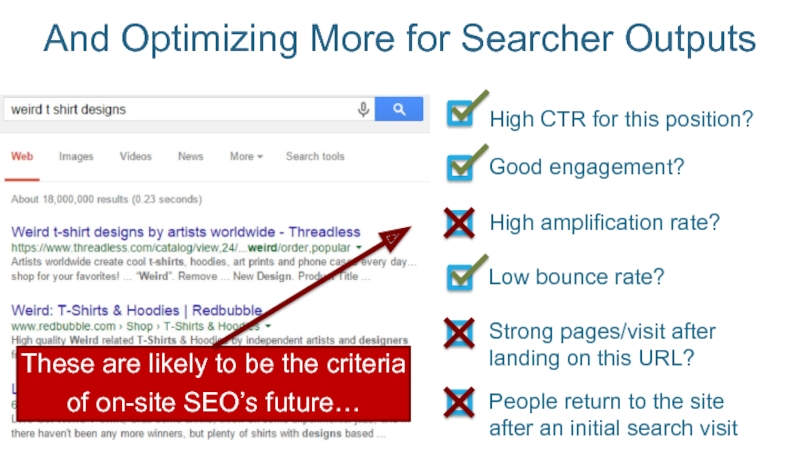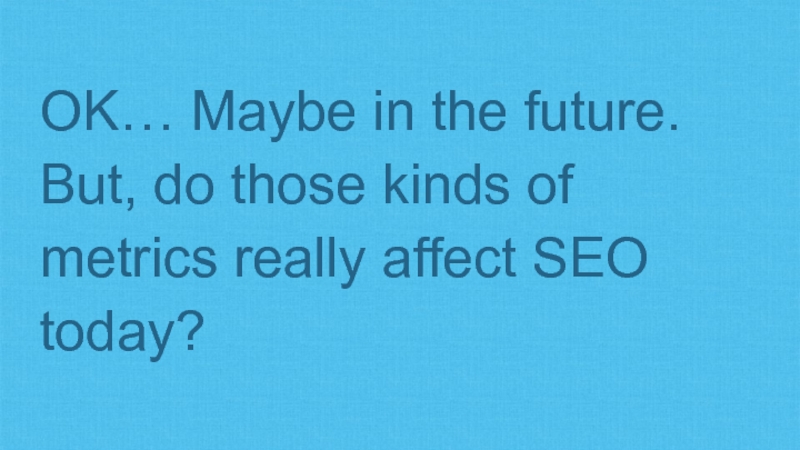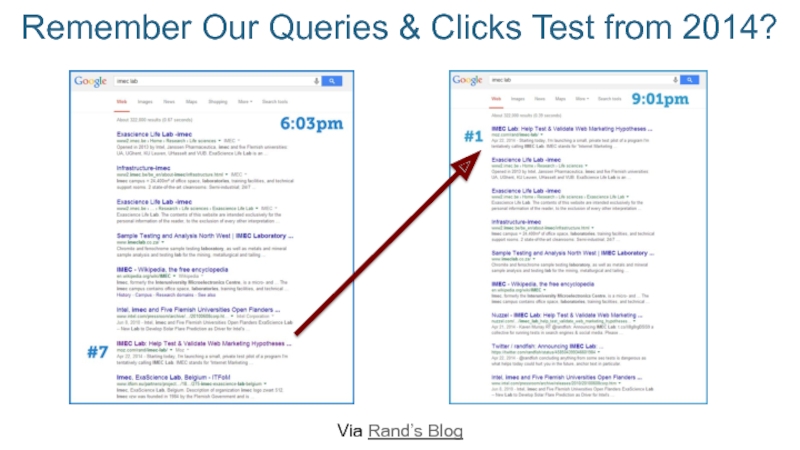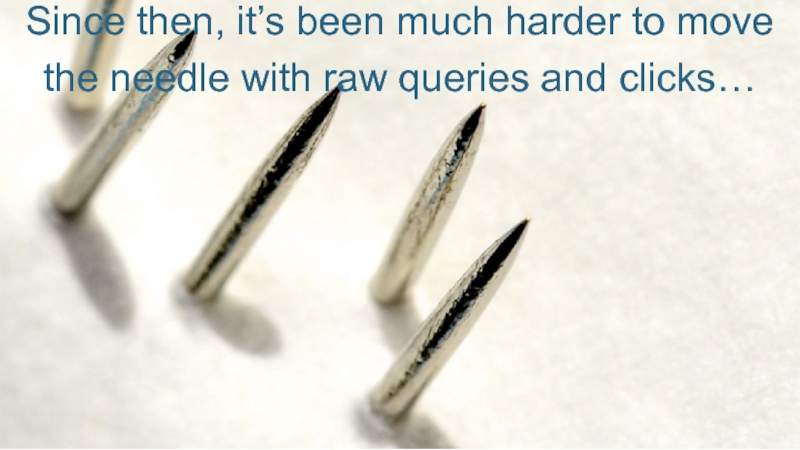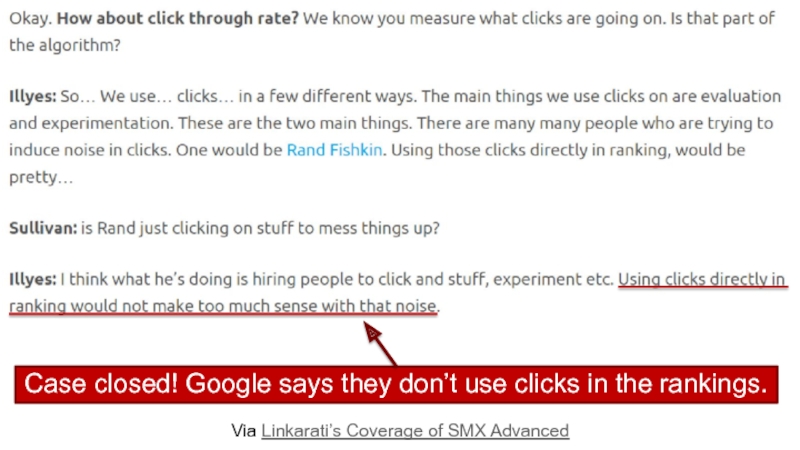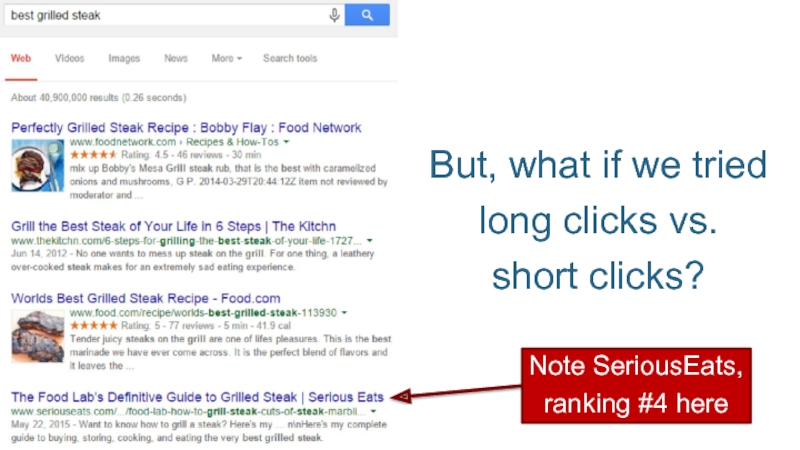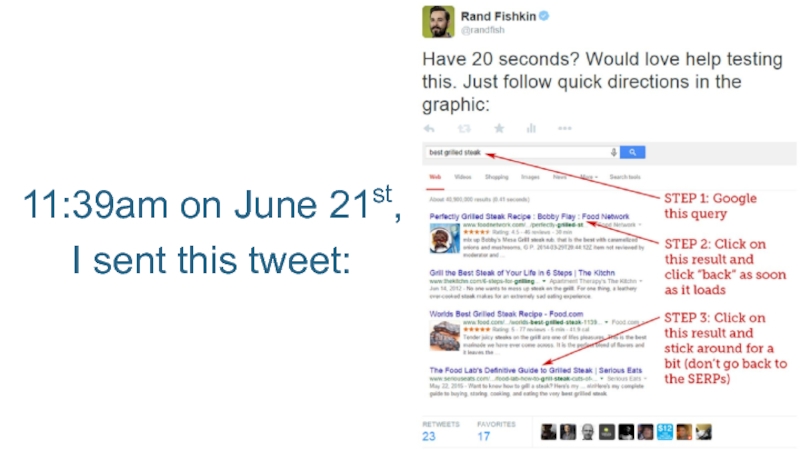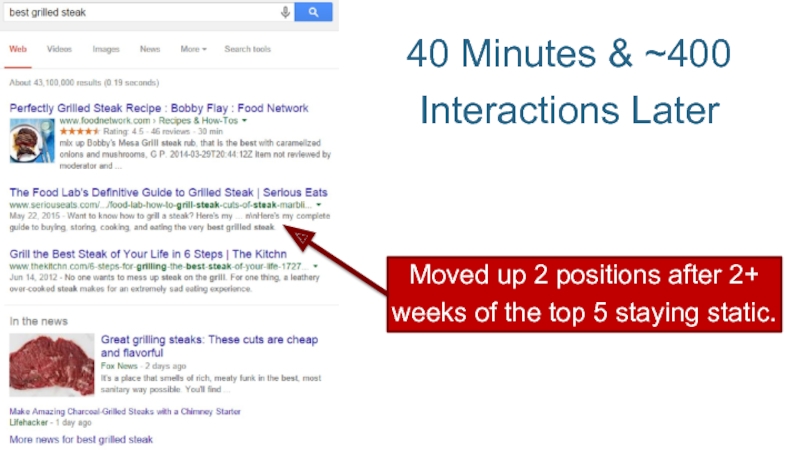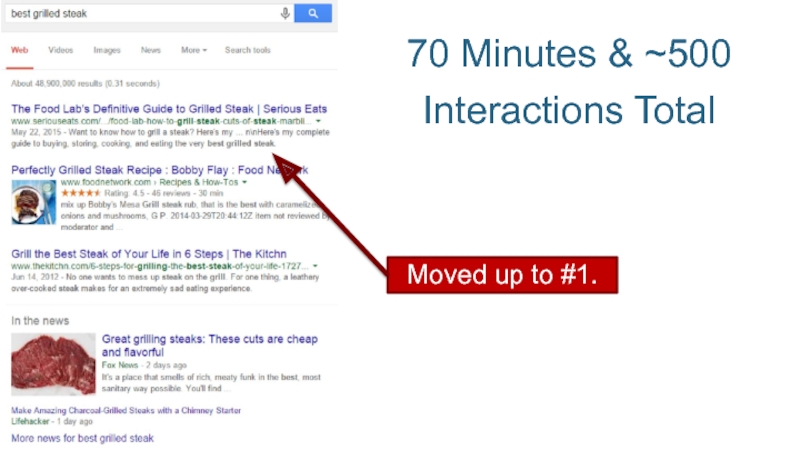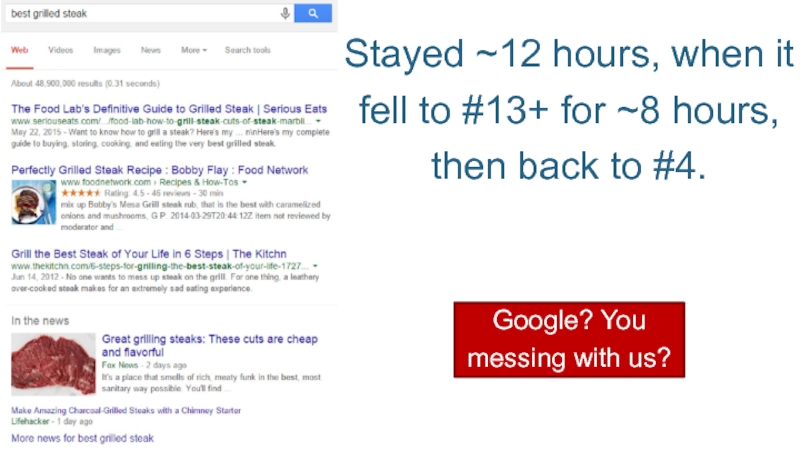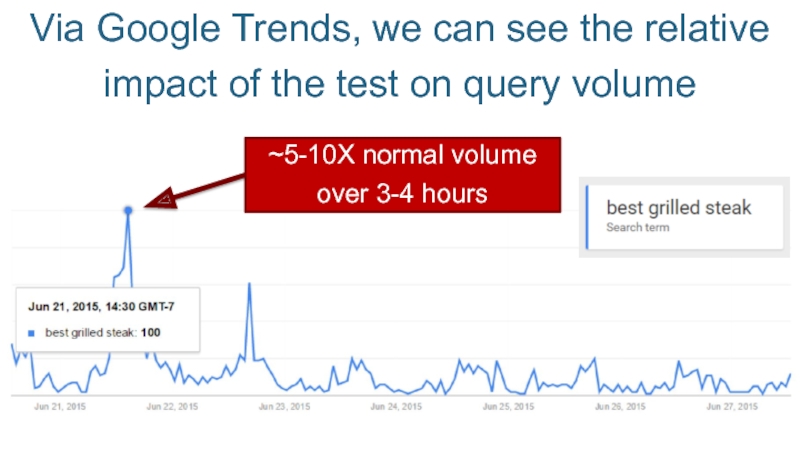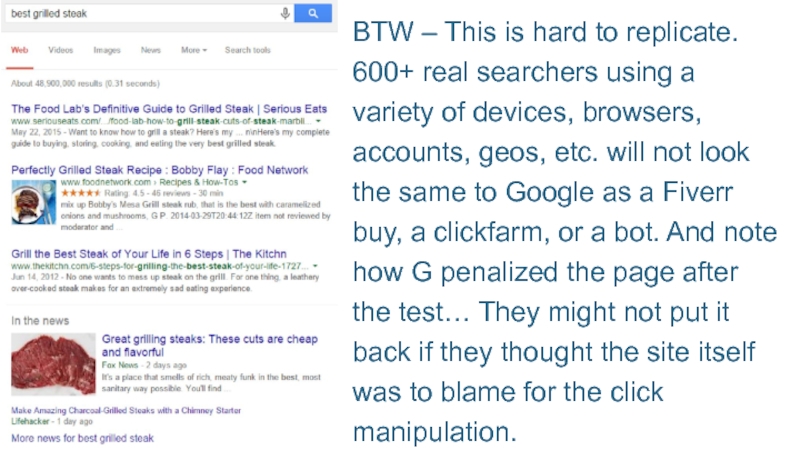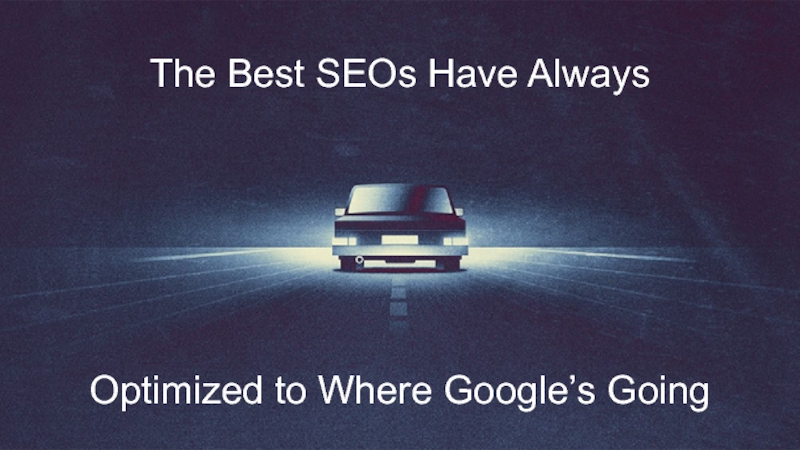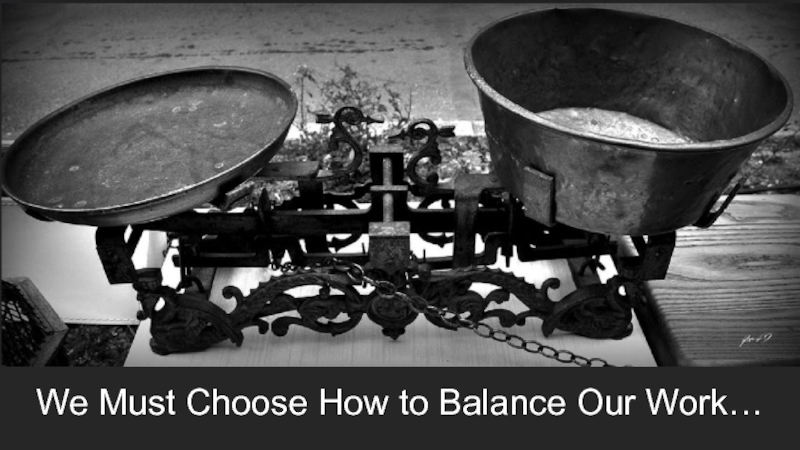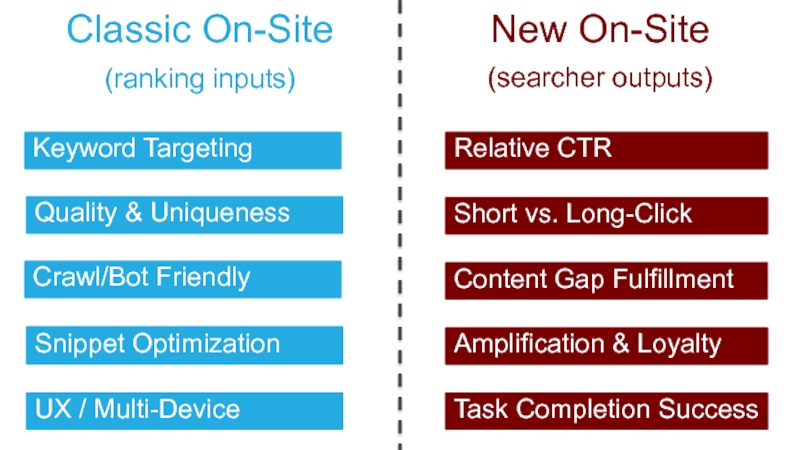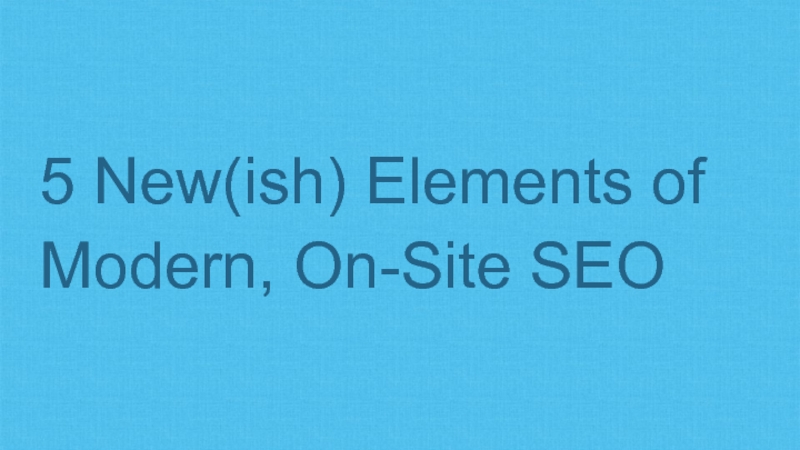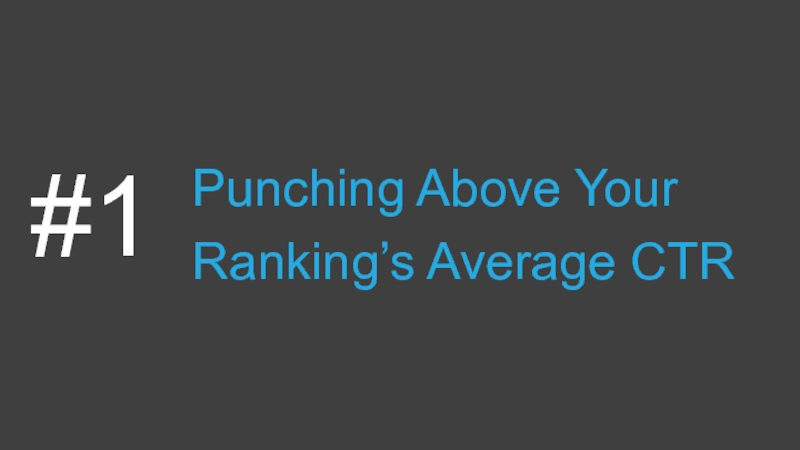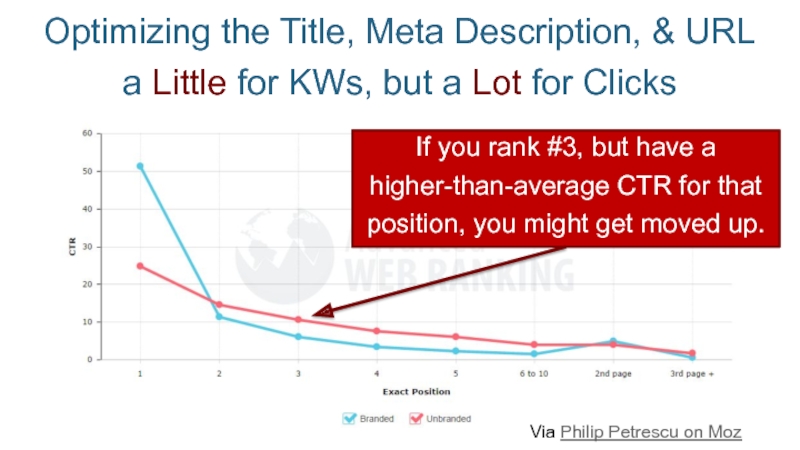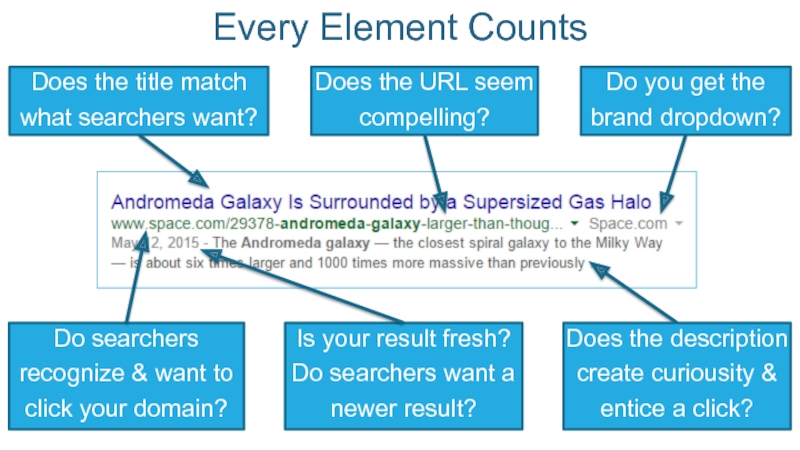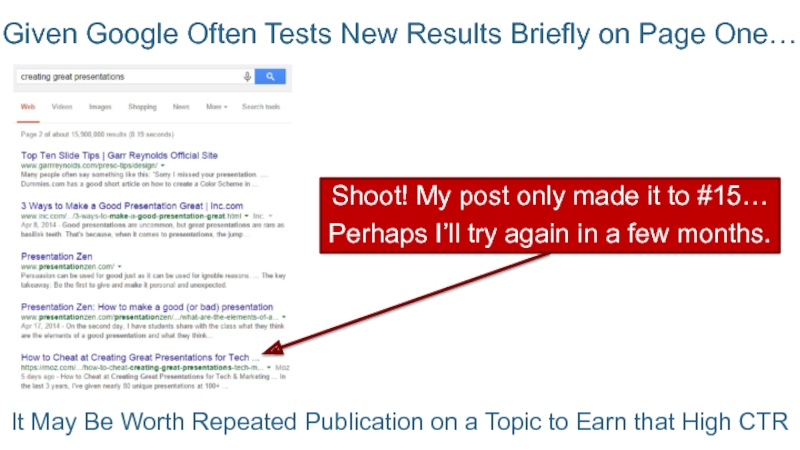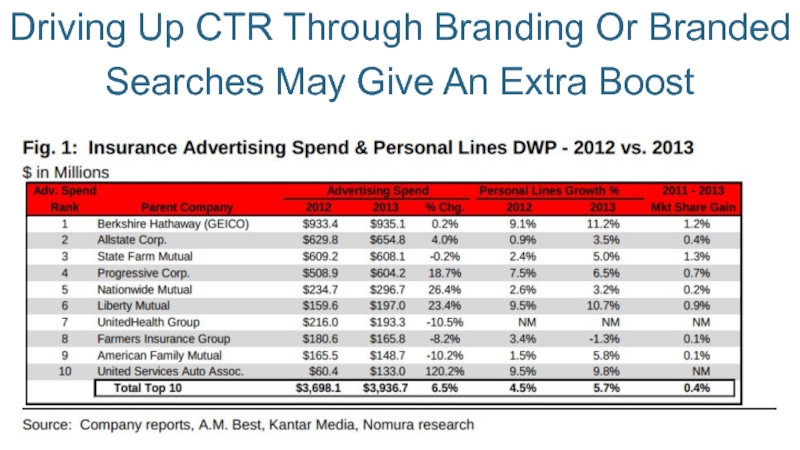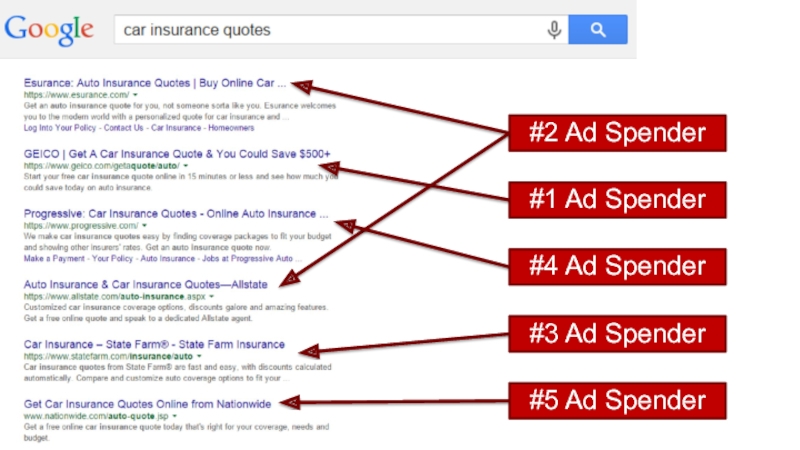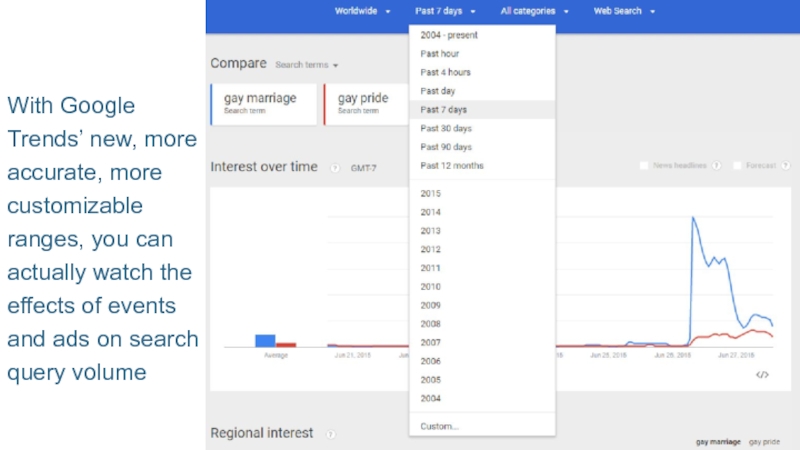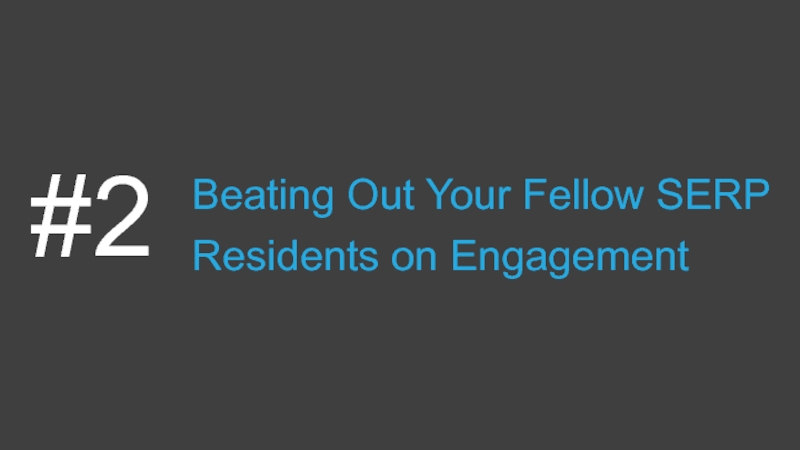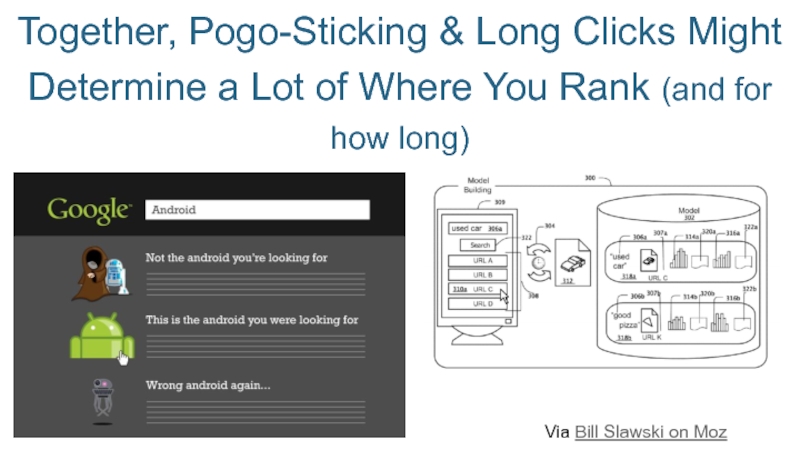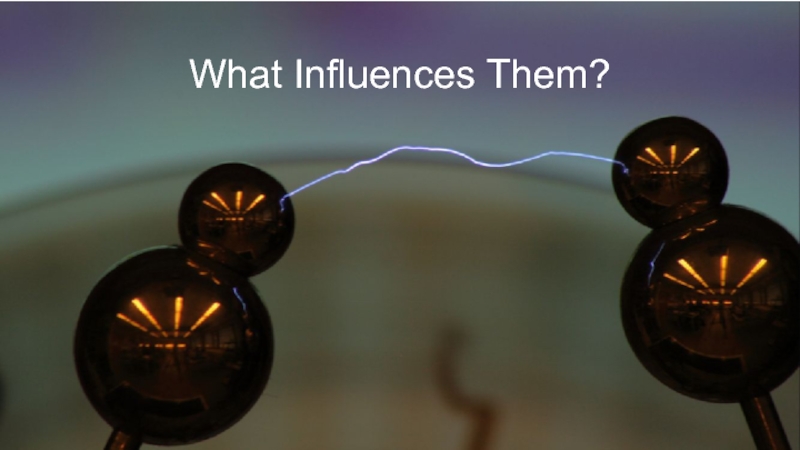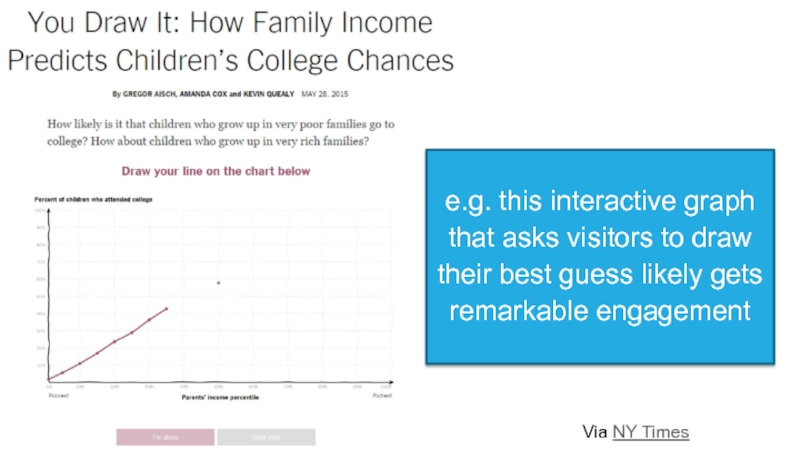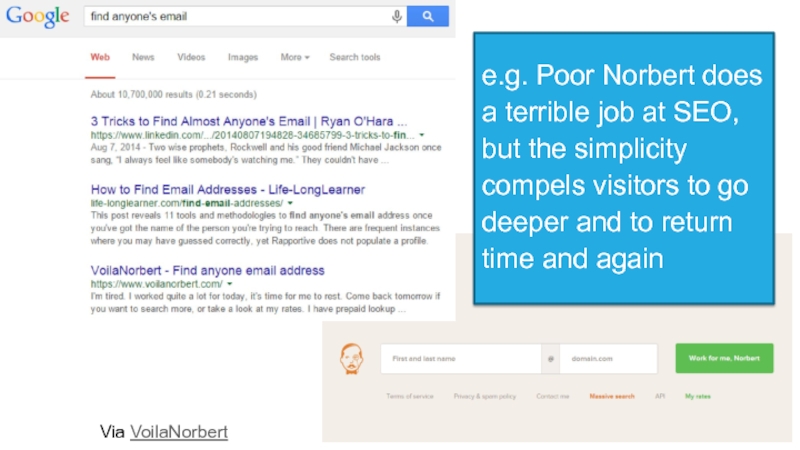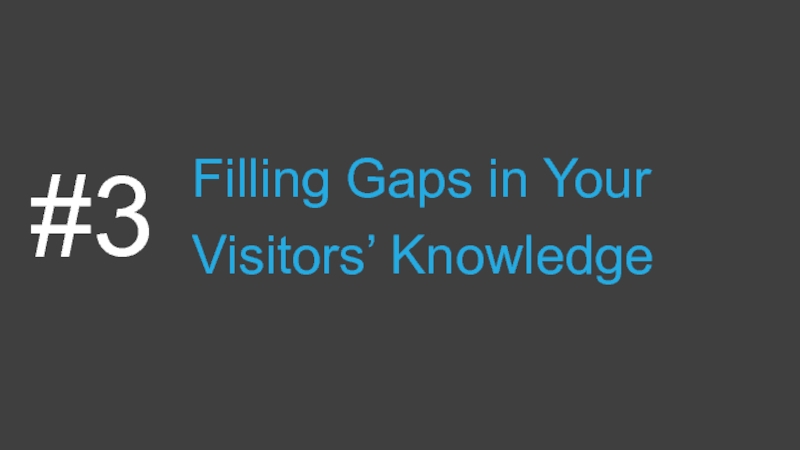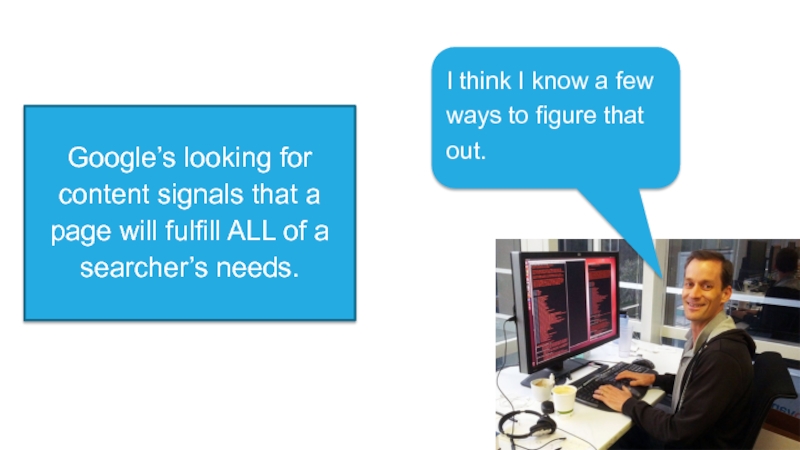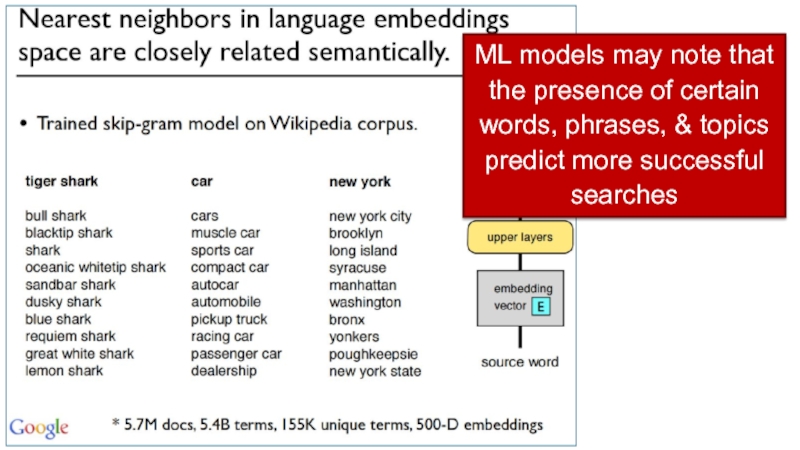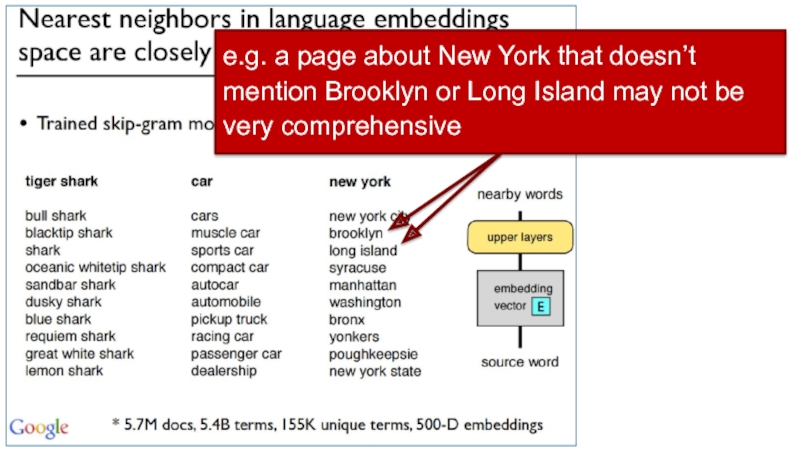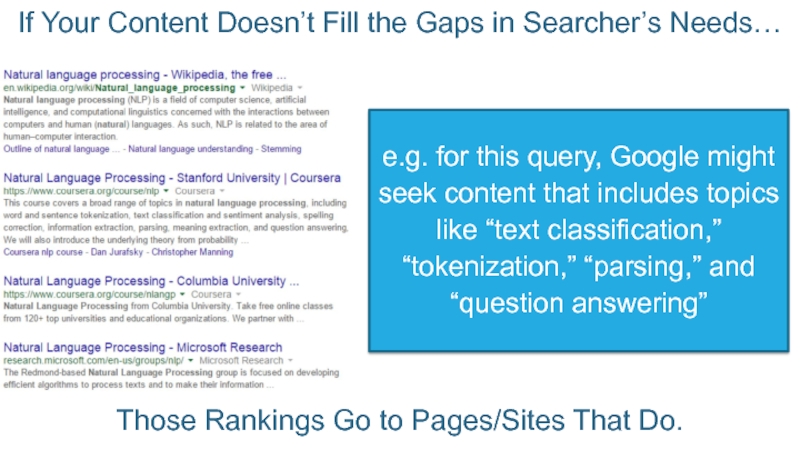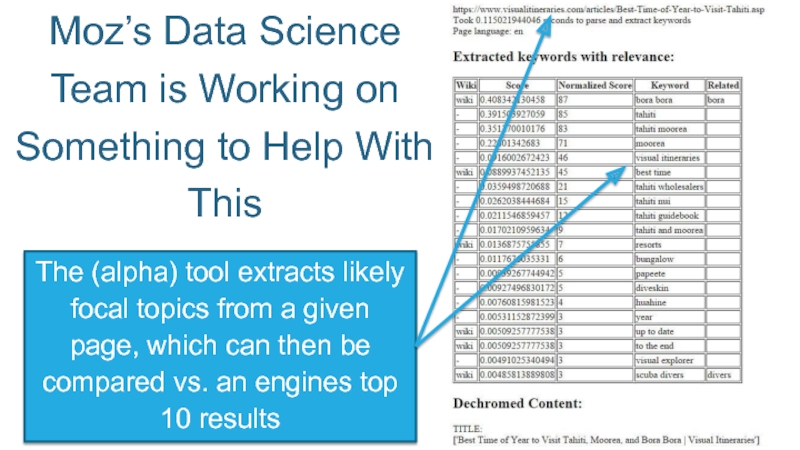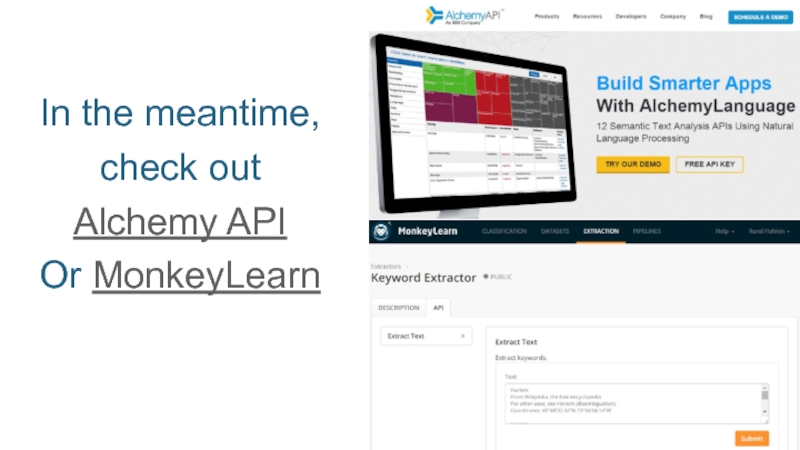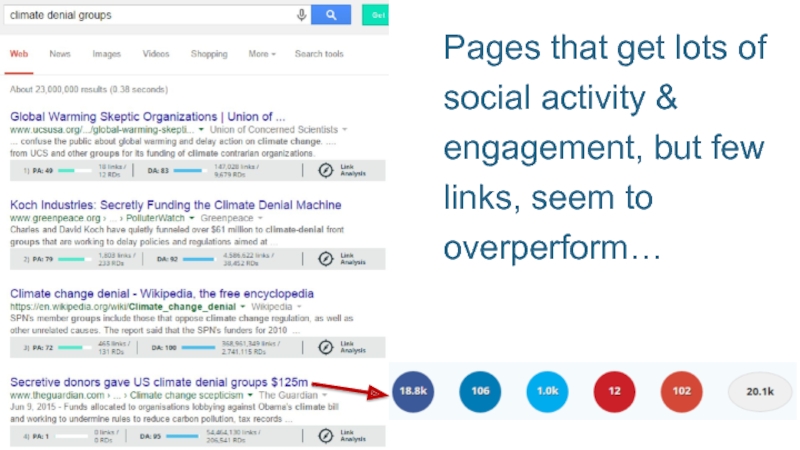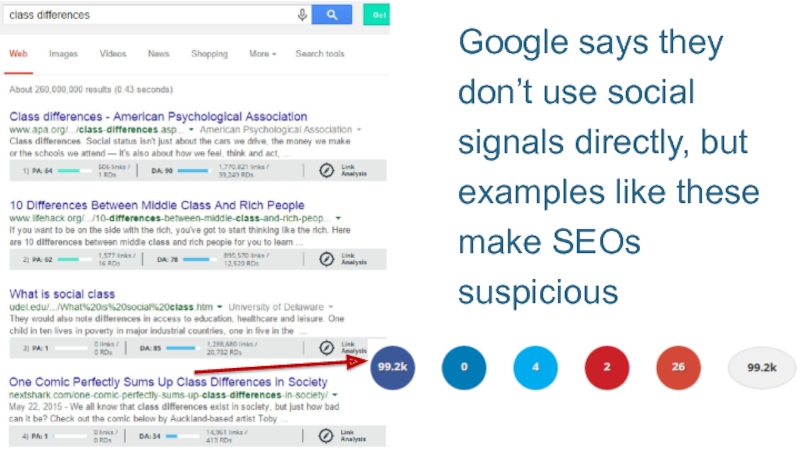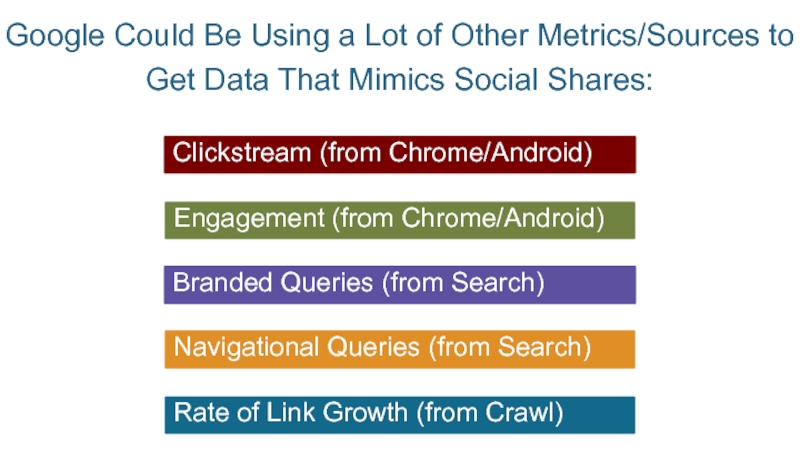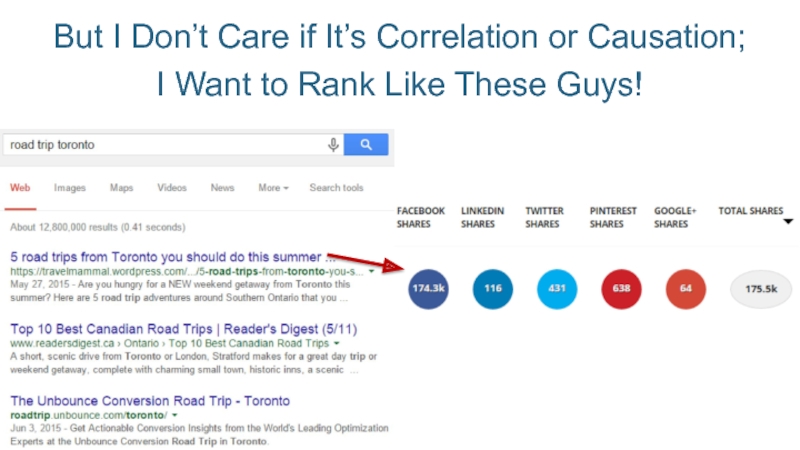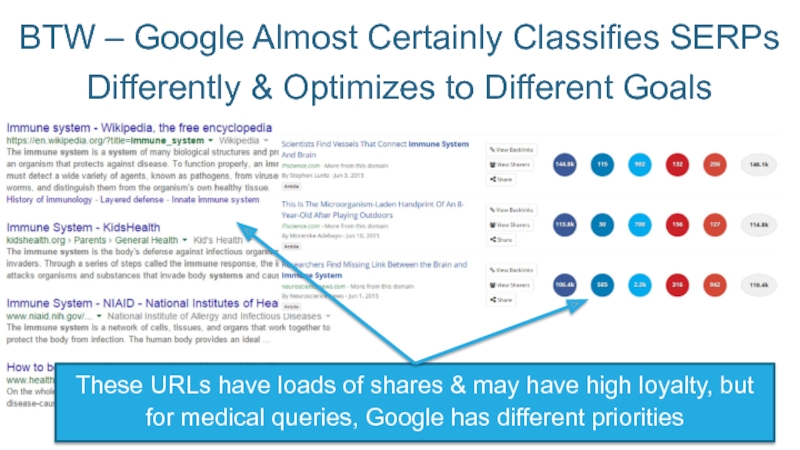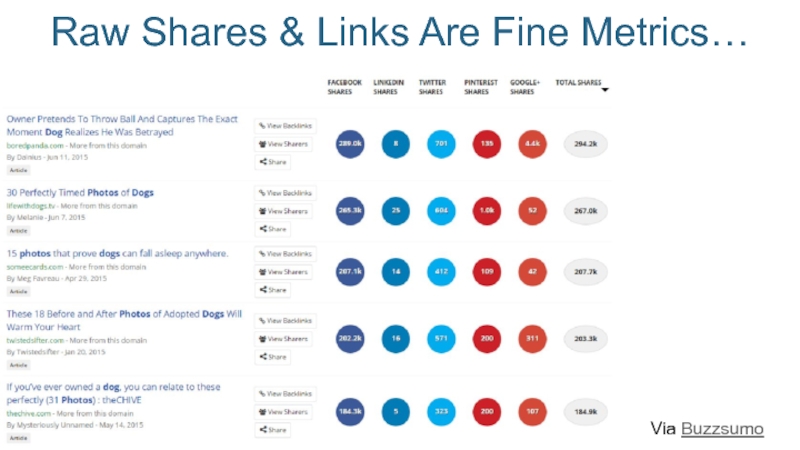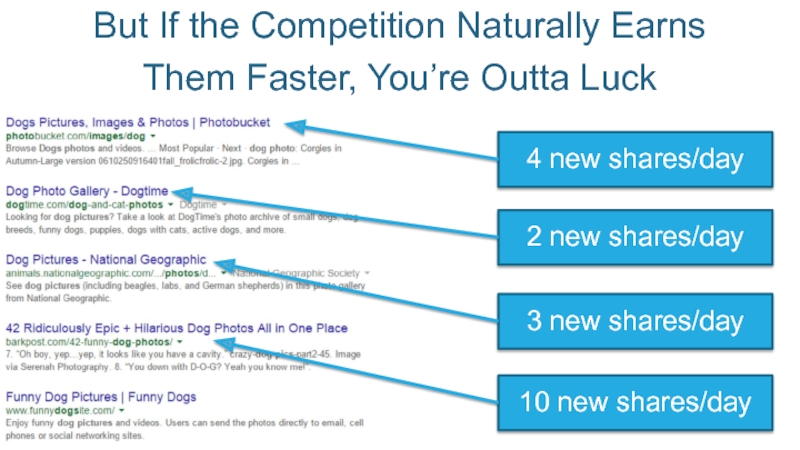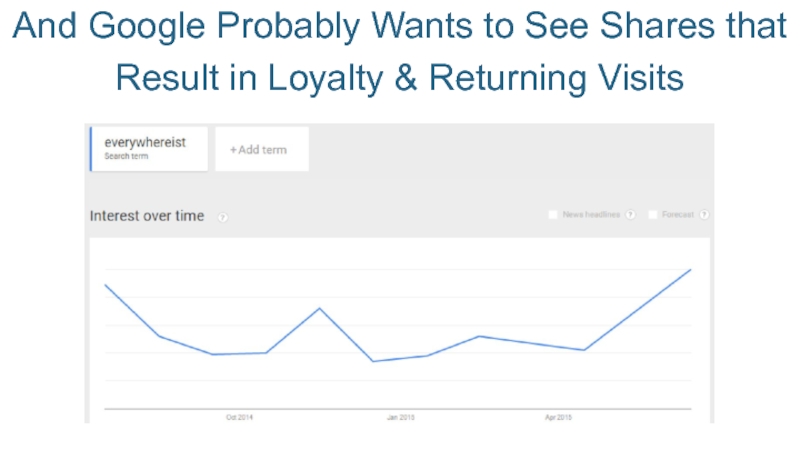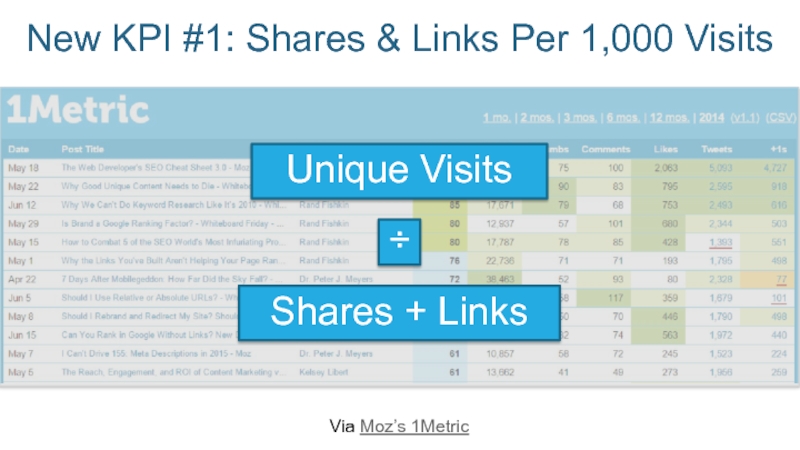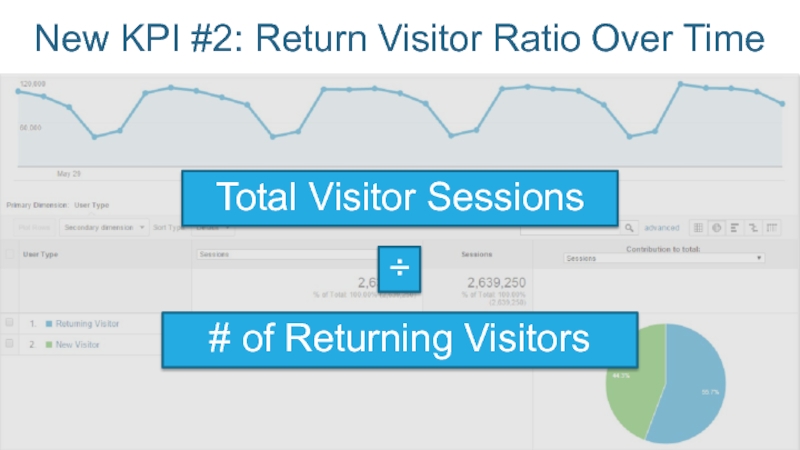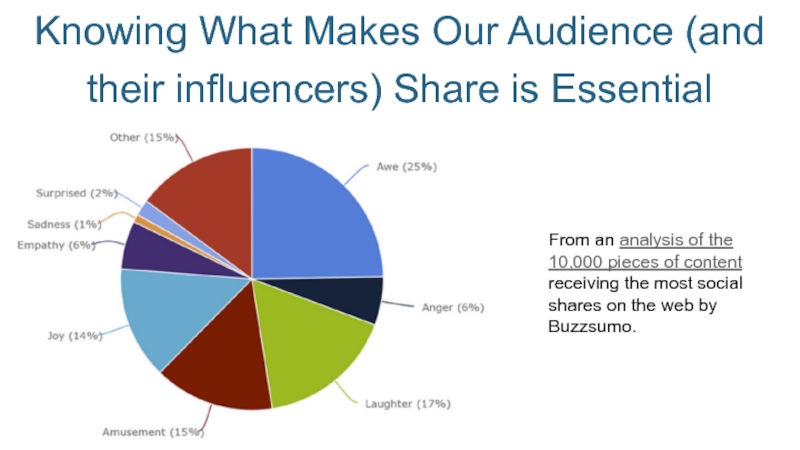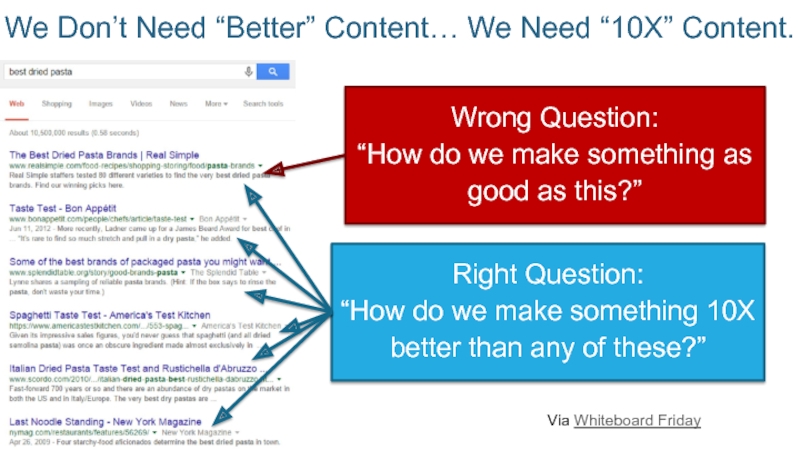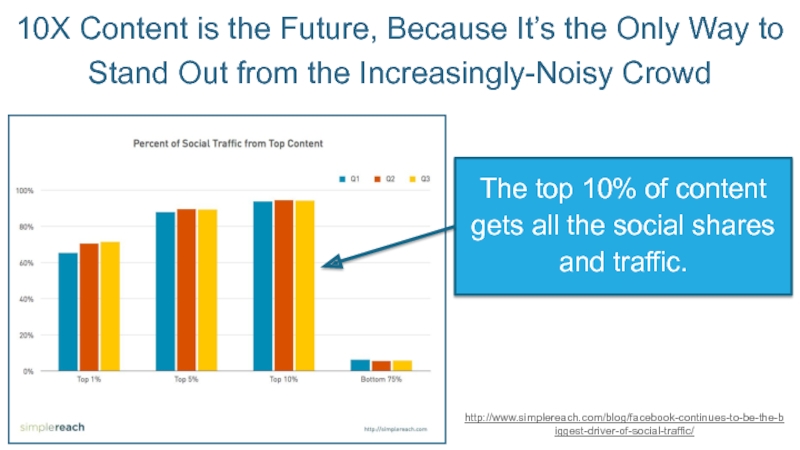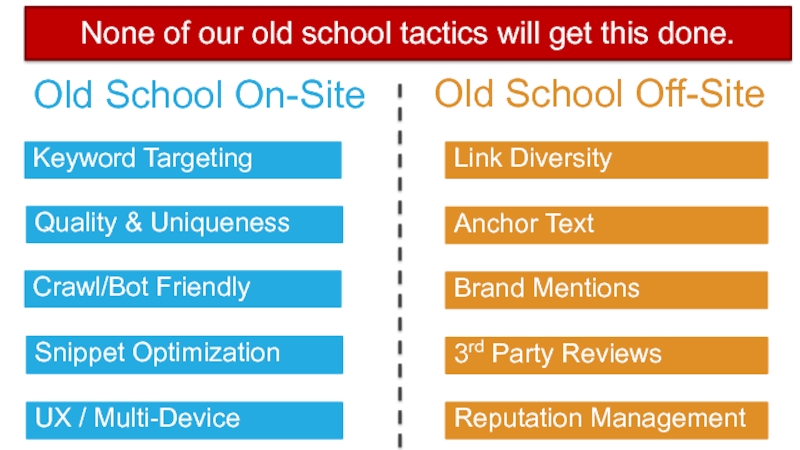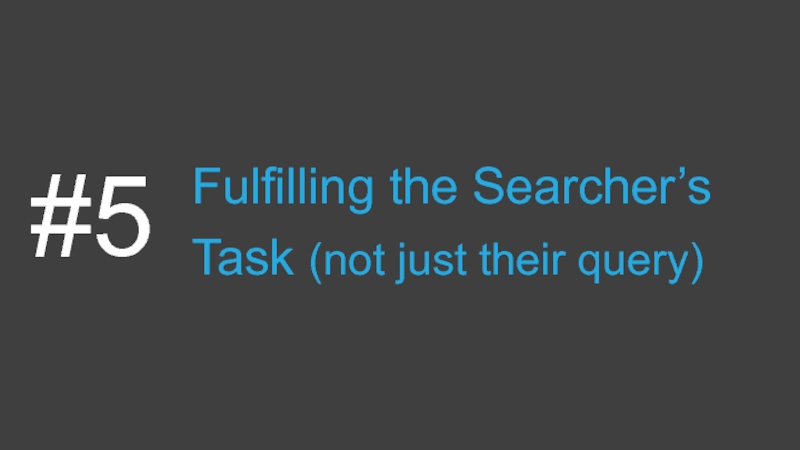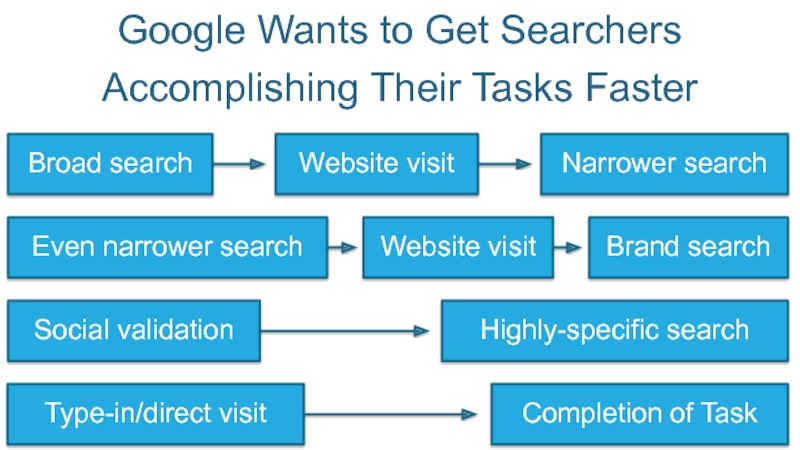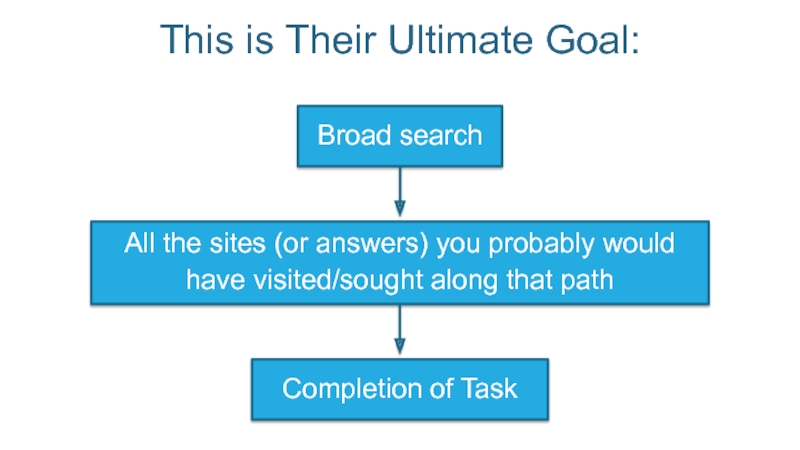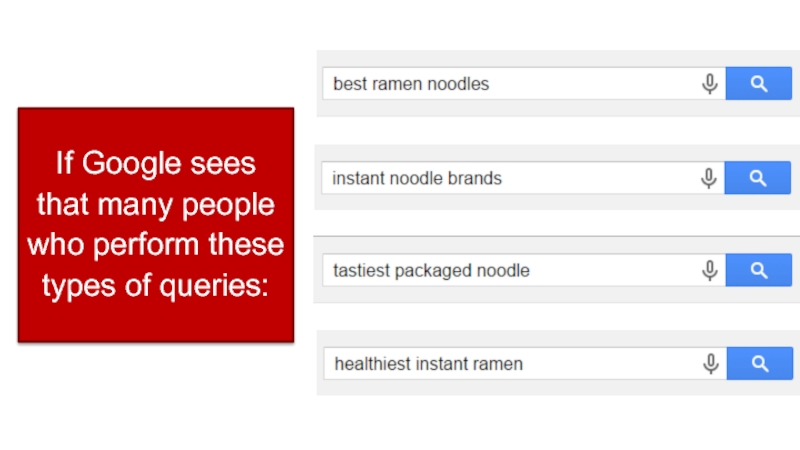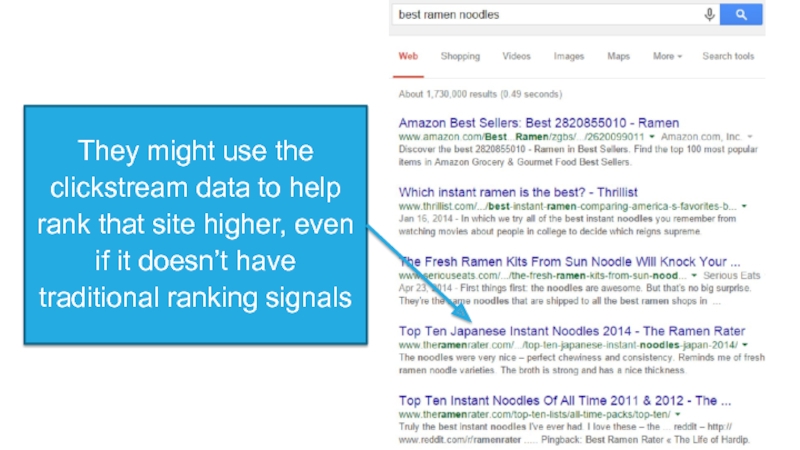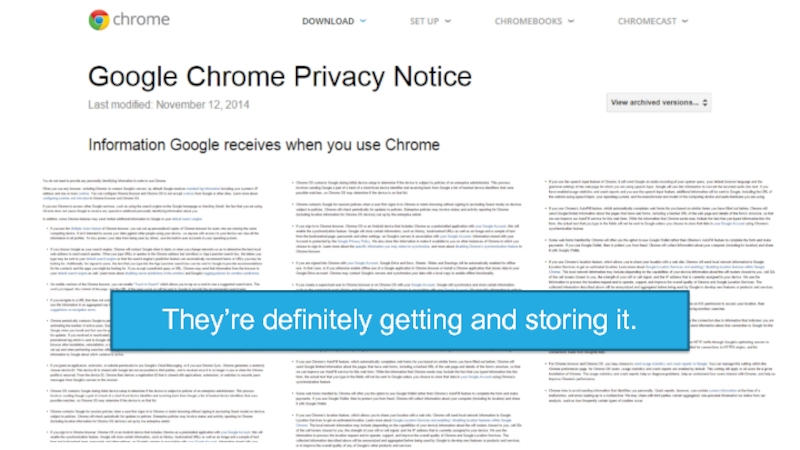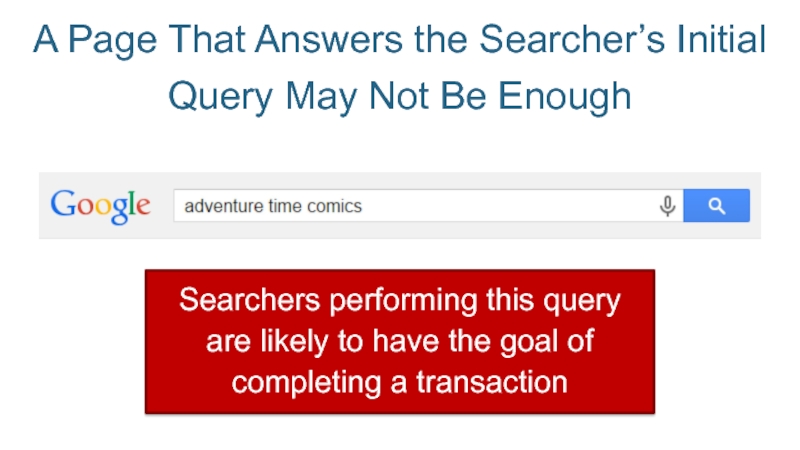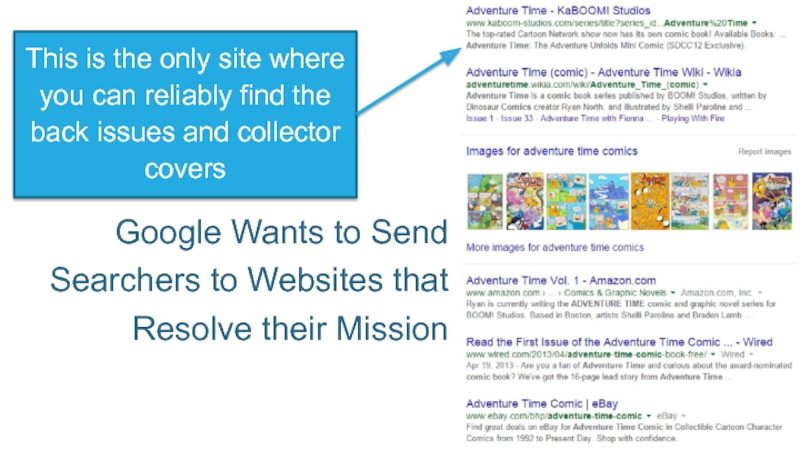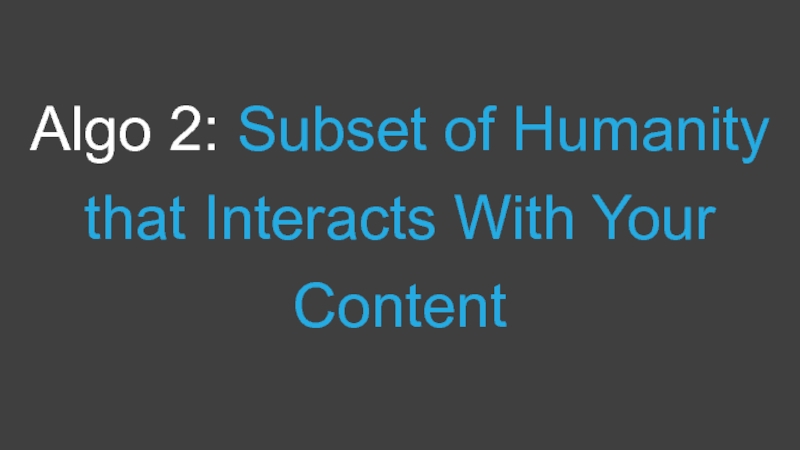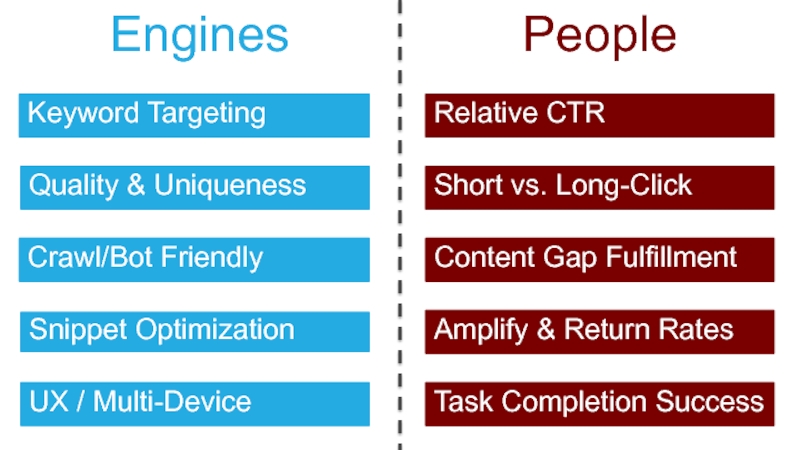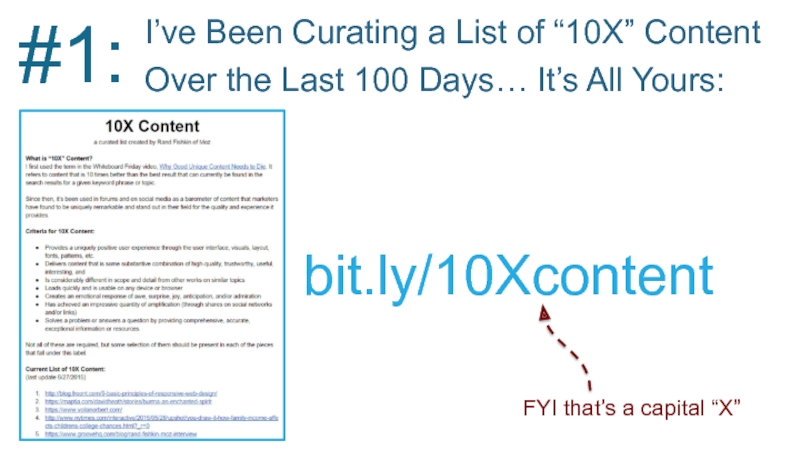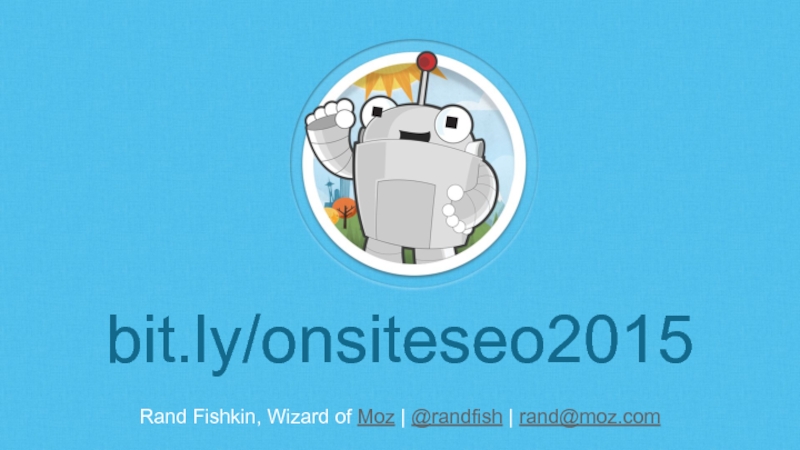- Главная
- Разное
- Дизайн
- Бизнес и предпринимательство
- Аналитика
- Образование
- Развлечения
- Красота и здоровье
- Финансы
- Государство
- Путешествия
- Спорт
- Недвижимость
- Армия
- Графика
- Культурология
- Еда и кулинария
- Лингвистика
- Английский язык
- Астрономия
- Алгебра
- Биология
- География
- Детские презентации
- Информатика
- История
- Литература
- Маркетинг
- Математика
- Медицина
- Менеджмент
- Музыка
- МХК
- Немецкий язык
- ОБЖ
- Обществознание
- Окружающий мир
- Педагогика
- Русский язык
- Технология
- Физика
- Философия
- Химия
- Шаблоны, картинки для презентаций
- Экология
- Экономика
- Юриспруденция
Onsite SEO in 2015: An Elegant Weapon for a More Civilized Marketer презентация
Содержание
- 2. bit.ly/onsiteseo2015 Get the presentation:
- 3. Remember When…
- 4. We Had One Job
- 5. Perfectly Optimized Pages
- 6. The Search Quality Teams Determined What to Include in the Ranking System
- 7. They decided links > content
- 8. By 2007, Link Spam Was Ubiquitous
- 9. Even in 2012, It Felt Like Google
- 10. Google’s Last 3 Years of Advancements Erased a Decade of Old School SEO Practices
- 11. They Finally Launched Effective Algorithms to Fight Manipulative Links & Content Via Google
- 12. And They Leveraged Fear + Uncertainty of
- 13. Google Figured Out Intent Rand
- 15. They Looked at Language, not Just Keywords Oh… I totally know this one!
- 17. They Predicted When We Want Diverse Results
- 19. They Figured Out When We Wanted Freshness
- 21. Their Segmentation of Navigational from Informational Queries Closed Many Loopholes
- 22. Google Learned to ID Entities of Knowledge
- 23. And to Connect Entities to Topics & Keywords Via Moz
- 24. Brands Became a Form of Entities
- 25. These Advancements Brought Google (mostly) Back in
- 26. During These Advances, Google’s Search Quality Team Underwent a Revolution
- 27. Early On, Google Rejected Machine Learning in
- 28. Amit Singhal Shared Norvig’s Concerns About ML Via Quora
- 29. In 2012, Google Published a Paper About
- 30. Susan Wojcicki, Google SVP, at All Things
- 31. By 2013, It Was Something Google’s Search Folks Talked About Publicly Via SELand
- 32. As ML Takes Over
- 33. Google is Public About How They Use
- 34. Google is Public About How They Use
- 35. Machine Learning in Search Could Work Like
- 36. Training Data (e.g. good search
- 37. Training Data (e.g. bad search
- 38. The Machines Learn to Emulate the Good
- 39. Deep Learning is Even More Advanced:
- 40. We’re Talking About Algorithms that Build Algorithms (without human intervention)
- 41. Googlers Don’t Feed in Ranking Factors… The
- 42. No wonder these guys are
- 43. What Does Deep Learning Mean for SEO?
- 44. Googlers Won’t Know Why Something Ranks or
- 45. The Query Success Metrics Will Be All
- 46. The Query Success Metrics Will Be All
- 47. We’ll Be Optimizing Less for Ranking Inputs
- 48. And Optimizing More for Searcher Outputs
- 49. OK… Maybe in the future. But, do those kinds of metrics really affect SEO today?
- 50. Remember Our Queries & Clicks Test from 2014? Via Rand’s Blog
- 51. Since then, it’s been much harder to
- 52. Case closed! Google says they
- 53. But, what if we tried long clicks
- 54. 11:39am on June 21st, I sent this tweet:
- 55. 40 Minutes & ~400 Interactions Later
- 56. 70 Minutes & ~500 Interactions Total Moved up to #1.
- 57. Stayed ~12 hours, when it fell to
- 58. Via Google Trends, we can
- 59. BTW – This is hard to replicate.
- 60. The Future: Optimizing for Two Algorithms
- 61. The Best SEOs Have Always Optimized to Where Google’s Going
- 62. Today, I Think We Know, Better Than
- 63. We Must Choose How to Balance Our Work…
- 64. Hammering on the Fading Signals of Old…
- 65. Or Embracing Those We Can See On the Rise
- 66. Classic On-Site (ranking inputs) New
- 67. 5 New(ish) Elements of Modern, On-Site SEO
- 68. Punching Above Your Ranking’s Average CTR #1
- 69. Optimizing the Title, Meta Description, & URL
- 70. Every Element Counts Does
- 71. Given Google Often Tests New Results Briefly
- 72. Driving Up CTR Through Branding Or Branded Searches May Give An Extra Boost
- 73. #1 Ad Spender #2 Ad Spender #4 Ad Spender #3 Ad Spender #5 Ad Spender
- 74. With Google Trends’ new, more accurate, more
- 75. Beating Out Your Fellow SERP Residents on Engagement #2
- 76. Together, Pogo-Sticking & Long Clicks Might Determine
- 77. What Influences Them?
- 78. Speed, Speed, and More Speed
- 79. Via NY Times e.g. this
- 80. e.g. Poor Norbert does a terrible job
- 81. e.g. Nomadlist’s superb, filterable database of cities and community for remote workers. Via Nomadlist
- 82. Filling Gaps in Your Visitors’ Knowledge #3
- 83. Google’s looking for content signals that a
- 84. ML models may note that the presence
- 85. e.g. a page about New York that
- 86. If Your Content Doesn’t Fill the Gaps
- 87. Moz’s Data Science Team is Working on
- 88. In the meantime, check out Alchemy API Or MonkeyLearn
- 89. Earning More Shares, Links, & Loyalty per Visit #4
- 90. Pages that get lots of social activity
- 91. Google says they don’t use
- 92. Even for insanely competitive keywords, we see
- 93. I suspect Google doesn’t use raw social
- 94. Google Could Be Using a Lot of
- 95. But I Don’t Care if It’s Correlation
- 96. BTW – Google Almost Certainly Classifies SERPs
- 97. Raw Shares & Links Are Fine Metrics… Via Buzzsumo
- 98. But If the Competition Naturally Earns Them
- 99. And Google Probably Wants to See Shares
- 100. New KPI #1: Shares & Links
- 101. New KPI #2: Return Visitor Ratio
- 102. Knowing What Makes Our Audience (and their
- 103. Knowing What Makes them Return (or prevents them from doing so) Is, Too.
- 104. We Don’t Need “Better” Content… We Need
- 105. 10X Content is the Future, Because It’s
- 106. Old School On-Site Old
- 107. Fulfilling the Searcher’s Task (not just their query) #5
- 108. Broad search Narrower search Even narrower search
- 109. Broad search All the sites (or answers)
- 110. If Google sees that many people who perform these types of queries:
- 111. Eventually end their queries on the topic after visiting Ramen Rater… The Ramen Rater
- 112. They might use the clickstream data to
- 113. They’re definitely getting and storing it.
- 114. A Page That Answers the Searcher’s Initial
- 115. Google Wants to Send Searchers to Websites
- 116. Welcome to the Two-Algorithm World of 2015
- 117. Algo 1: Google
- 118. Algo 2: Subset of Humanity that Interacts With Your Content
- 119. “Make Pages for People, Not Engines.”
- 120. Terrible Advice.
- 121. Keyword Targeting Relative CTR Short vs.
- 122. Optimize for Both: Algo Input & Human Output
- 123. Bonus Time!
- 124. I’ve Been Curating a List of “10X”
- 125. MonkeyLearn created a tool just for Mozcon
- 126. Rand Fishkin, Wizard of Moz | @randfish | rand@moz.com bit.ly/onsiteseo2015
Слайд 8By 2007, Link Spam Was Ubiquitous
This paper/presentation from Yahoo’s spam team
Слайд 9Even in 2012, It Felt Like Google Was Making Liars Out
Via Wil Reynolds
Слайд 13Google Figured Out Intent
Rand probably doesn’t just want webpages filled with
Слайд 19They Figured Out When We Wanted Freshness
Old pages on this topic
Слайд 30Susan Wojcicki, Google SVP, at All Things Digital, 2012
“Our SmartASS system
Слайд 32
As ML Takes Over More of Google’s Algo, the Underpinnings of
Via Colossal
Слайд 33Google is Public About How They Use ML in Image Recognition
Potential ID Factors
(e.g. color, shapes, gradients, perspective, interlacing, alt tags, surrounding text, etc)
Training Data
(i.e. human-labeled images)
Learning Process
Best Match Algo
Слайд 34Google is Public About How They Use ML in Image Recognition
Via Jeff Dean’s Slides on Deep Learning; a Must Read for SEOs
Слайд 35Machine Learning in Search Could Work Like This:
Potential Ranking Factors
(e.g. PageRank,
Topic Modeling, QDF, Clicks, Entity Association, etc.)
Training Data
(i.e. good & bad search results)
Learning Process
Best Fit Algo
Слайд 36
Training Data
(e.g. good search results)
This is a good SERP – searchers
Слайд 37
Training Data
(e.g. bad search results!)
This is a bad SERP – searchers
Слайд 38The Machines Learn to Emulate the Good Results & Try to
Potential Ranking Factors
(e.g. PageRank, TF*IDF,
Topic Modeling, QDF, Clicks, Entity Association, etc.)
Training Data
(i.e. good & bad search results)
Learning Process
Best Fit Algo
Слайд 39Deep Learning is Even More Advanced:
Dean says by using deep learning,
Слайд 41Googlers Don’t Feed in Ranking Factors… The Machines Determine Those Themselves.
Potential
Topic Modeling, QDF, Clicks, Entity Association, etc.)
Training Data
(i.e. good search results)
Learning Process
Best Fit Algo
Слайд 42
No wonder these guys are stressed about Google unleashing the Terminators
Via CNET & Washington Post
Слайд 44Googlers Won’t Know Why Something Ranks or Whether a Variable’s in
He means other Googlers.
I’m Jeff Dean. I’ll know.
Слайд 45The Query Success Metrics Will Be All That Matters to the
Long to Short Click Ratio
Relative CTR vs. Other Results
Rate of Searchers Conducting Additional, Related Searches
Metrics of User Engagement on the Page
Metrics of User Engagement Across the Domain
Sharing/Amplifcation Rate vs. Other Results
Слайд 46The Query Success Metrics Will Be All That Matters to the
Long to Short Click Ratio
Relative CTR vs. Other Results
Rate of Searchers Conducting Additional, Related Searches
Metrics of User Engagement on the Page
Metrics of User Engagement Across the Domain
Sharing/Amplifcation Rate vs. Other Results
If lots of results on a SERP do these well, and higher results outperform lower results, our deep learning algo will consider it a success.
Слайд 47We’ll Be Optimizing Less
for Ranking Inputs
Unique Linking Domains
Keywords in Title
Anchor Text
Content
Page Load Speed
Слайд 48And Optimizing More for Searcher Outputs
High CTR for this position?
Good engagement?
High
Low bounce rate?
Strong pages/visit after
landing on this URL?
These are likely to be the criteria of on-site SEO’s future…
People return to the site
after an initial search visit
Слайд 52
Case closed! Google says they don’t use clicks in the rankings.
Via
Слайд 5540 Minutes & ~400 Interactions Later
Moved up 2 positions after 2+
Слайд 57Stayed ~12 hours, when it fell to #13+ for ~8 hours,
Google? You messing with us?
Слайд 58
Via Google Trends, we can see the relative impact of the
~5-10X normal volume over 3-4 hours
Слайд 59BTW – This is hard to replicate. 600+ real searchers using
Слайд 62Today, I Think We Know,
Better Than Ever, Where That Is
Welcome to
Слайд 66
Classic On-Site
(ranking inputs)
New On-Site
(searcher outputs)
Keyword Targeting
Relative CTR
Short vs. Long-Click
Content Gap Fulfillment
Amplification
Task Completion Success
Quality & Uniqueness
Crawl/Bot Friendly
Snippet Optimization
UX / Multi-Device
Слайд 69Optimizing the Title, Meta Description, & URL
a Little for KWs, but
If you rank #3, but have a higher-than-average CTR for that position, you might get moved up.
Via Philip Petrescu on Moz
Слайд 70Every Element Counts
Does the title match what searchers want?
Does the
Do searchers recognize & want to click your domain?
Is your result fresh? Do searchers want a newer result?
Does the description create curiousity & entice a click?
Do you get the brand dropdown?
Слайд 71Given Google Often Tests New Results Briefly on Page One…
It May
Shoot! My post only made it to #15… Perhaps I’ll try again in a few months.
Слайд 74With Google Trends’ new, more accurate, more customizable ranges, you can
Слайд 76Together, Pogo-Sticking & Long Clicks Might Determine a Lot of Where
Via Bill Slawski on Moz
Слайд 78Speed, Speed, and More Speed
Delivers the Best UX on Every Browser
Compels
Avoids Features that Annoy or Dissuade Visitors
Content that Fulfills the Searcher’s Conscious & Unconscious Needs
An SEO’s Checklist for Better Engagement:
Слайд 79
Via NY Times
e.g. this interactive graph that asks visitors to draw
Слайд 80e.g. Poor Norbert does a terrible job at SEO, but the
Via VoilaNorbert
Слайд 81e.g. Nomadlist’s superb, filterable database of cities and community for remote
Via Nomadlist
Слайд 83Google’s looking for content signals that a page will fulfill ALL
I think I know a few ways to figure that out.
Слайд 84ML models may note that the presence of certain words, phrases,
Слайд 85e.g. a page about New York that doesn’t mention Brooklyn or
Слайд 86If Your Content Doesn’t Fill the Gaps in Searcher’s Needs…
e.g. for
Those Rankings Go to Pages/Sites That Do.
Слайд 87Moz’s Data Science Team is Working on Something to Help With
The (alpha) tool extracts likely focal topics from a given page, which can then be compared vs. an engines top 10 results
Слайд 91
Google says they don’t use social signals directly, but examples like
Слайд 92Even for insanely competitive keywords, we see this type of behavior
Слайд 93I suspect Google doesn’t use raw social shares as a ranking
Via Chartbeat
Слайд 94Google Could Be Using a Lot of Other Metrics/Sources to Get
Clickstream (from Chrome/Android)
Engagement (from Chrome/Android)
Branded Queries (from Search)
Navigational Queries (from Search)
Rate of Link Growth (from Crawl)
Слайд 96BTW – Google Almost Certainly Classifies SERPs Differently & Optimizes to
These URLs have loads of shares & may have high loyalty, but for medical queries, Google has different priorities
Слайд 98But If the Competition Naturally Earns
Them Faster, You’re Outta Luck
4 new
2 new shares/day
3 new shares/day
10 new shares/day
Слайд 102Knowing What Makes Our Audience (and their influencers) Share is Essential
From
Слайд 104We Don’t Need “Better” Content… We Need “10X” Content.
Via Whiteboard Friday
Wrong
“How do we make something as good as this?”
Right Question:
“How do we make something 10X better than any of these?”
Слайд 10510X Content is the Future, Because It’s the Only Way to
http://www.simplereach.com/blog/facebook-continues-to-be-the-biggest-driver-of-social-traffic/
The top 10% of content gets all the social shares and traffic.
Слайд 106
Old School On-Site
Old School Off-Site
Keyword Targeting
Link Diversity
Anchor Text
Brand Mentions
3rd Party Reviews
Reputation
Quality & Uniqueness
Crawl/Bot Friendly
Snippet Optimization
UX / Multi-Device
None of our old school tactics will get this done.
Слайд 108Broad search
Narrower search
Even narrower search
Website visit
Website visit
Brand search
Social validation
Highly-specific search
Type-in/direct visit
Completion
Google Wants to Get Searchers Accomplishing Their Tasks Faster
Слайд 109Broad search
All the sites (or answers) you probably would have visited/sought
Completion of Task
This is Their Ultimate Goal:
Слайд 112They might use the clickstream data to help rank that site
Слайд 114A Page That Answers the Searcher’s Initial Query May Not Be
Searchers performing this query are likely to have the goal of completing a transaction
Слайд 115Google Wants to Send Searchers to Websites that Resolve their Mission
This
Слайд 121
Keyword Targeting
Relative CTR
Short vs. Long-Click
Content Gap Fulfillment
Amplify & Return Rates
Task
Quality & Uniqueness
Crawl/Bot Friendly
Snippet Optimization
UX / Multi-Device
Engines
People
Слайд 124I’ve Been Curating a List of “10X” Content Over the Last
#1:
bit.ly/10Xcontent
FYI that’s a capital “X”
Слайд 125MonkeyLearn created a tool just for Mozcon to help w/ topic
#2:
Bit.ly/monkeylearnseo
